2022 SURE Fellows
Read research from the 2022 Columbia University and Amazon Summer Undergraduate Research Experience (SURE) 2022 fellows.
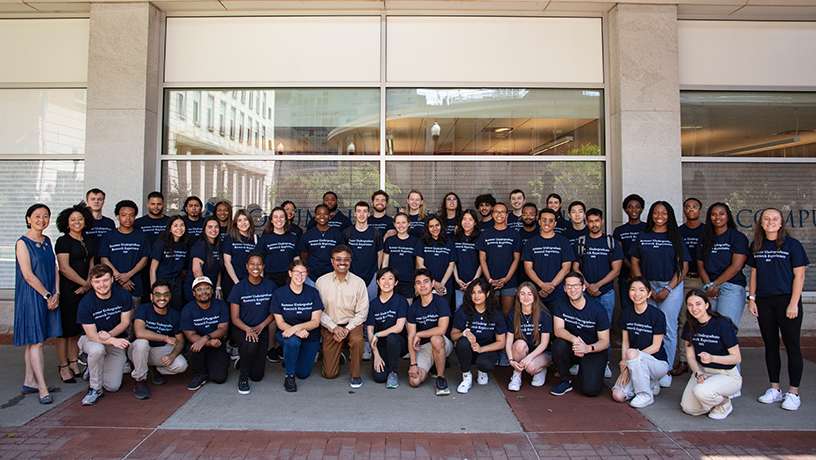
The Columbia University and Amazon SURE Program
The Columbia University and Amazon Summer Undergraduate Research Experience (SURE) Program was established in an effort to increase diversity in the science and engineering fields by providing a unique summer research experience for a cohort of students from historically underrepresented and minority backgrounds. The SURE Program welcomed its second cohort in the Summer of 2022. Fellows participated in 10 weeks of summer research and professional development culminating in an end-of-summer research symposium.
On This Page
- Aamna Siddiqui
- Alfonso Rivas
- Asim Omi
- Bianca Byfield
- Brandan Herron
- Bridgie Cawthon Jr.
- Conrad Wyrick
- Courtney Chan
- Dominic Peters
- Duaa Tariq
- Eve Fantozzi
- Gianna Brown
- Gianna Scibilio
- Hailey Onweller
- Harshdeep Aujla
- Hayato Takai
- Isabel Wallgren
- Isabella C. Huang
- Jade Carter
- Jake Joseph
- Jay Easter
- Jazmyn Jenkins
- Jessica Quinones
- Jose Olivera
- Justin Norwood
- Justin Walkup
- Lydia Kresin
- Macarena Peralta
- Miccaella Lejwa
- Michael Jordan
- Mohamed Wagiealla
- Nachum Twersky
- Nia Cole
- Noah Robison
- Omar Dervisevic
- Prasun Dutta Gupta
- Riley Fisher
- Robert Ward
- Samuel Cohen
- Sara Kesan
- Sasha Kucher
- Stephanie Morales
- Tiffany Kalu
- Tiffany Nieto
- Victoria W. Tung
- Wendy Zimmerman
- Zachary George
Aamna Siddiqui | The Hung Lab
- Mentor: Clark T. Hung, Biomedical Engineering
- Home Institution: Virginia Commonwealth University
- Hometown: Clarksburg, MD
Assessing Changes in Mechanosensitivity in Fibroblast-like Synoviocytes in response to siRNA-mediated IFT88 Knockdown
Introduction: The synovium lines articulating joints and maintains a lubricating environment.1 Fibroblast-like synoviocytes (FLS) reside in the synovial lining, where they are exposed to the dynamic fluid environment within the knee. Fluid shear has been shown to affect FLS function; calcium signaling is an indicator of responses to mechanical stimuli.2 Intraflagellar Transport Protein 88 (IFT88) knockdown has been shown to reduce primary cilia incidence.3 We hypothesize that IFT88 knockdown will modulate FLS mechanosensitivity to fluid shear by altering primary cilia incidence or length.
Methods: FLS were obtained by pooling cells from 3 cadavers. IFT88 primers were optimized by qPCR prior to use. siRNA knockdown of IFT88 was optimized for transfected RNA quantity. Transfected and control FLS were loaded onto custom parallel plate flow chambers and subjected to 0.1Pa fluid shear stress. Calcium response was analyzed using a custom Matlab script.
Results: IFT88 Primer Two was optimal, with an efficiency of 99.87%. Transfection with 10 pmol siRNA was found to reduce IFT88 mRNA by 77%. Peak latency increased among IFT88 knockdown FLS relative to control by 29.66% (p<0.0001).
Conclusion: IFT88 knockdown in FLS alters mechanosensitivity by increasing the time required for stimulated cells to produce a calcium transient (peak latency). Altered mechanosensitivity may be due to changes in cilia incidence or length. Future studies will aim to correlate cilia properties with mechanosensitivity in FLS. Understanding how the synovium senses and responds to its mechanical environment can inform future studies of joint diseases and potential therapies.
References: 1Hui + Wiley Interdiscip Rev Syst Biol Med, 2011; 2Estell + J Biomech, 2017; 3Huangfu + Nature, 2003; 4Sakhrani + Front. Bioeng. Biotechnol, 2022
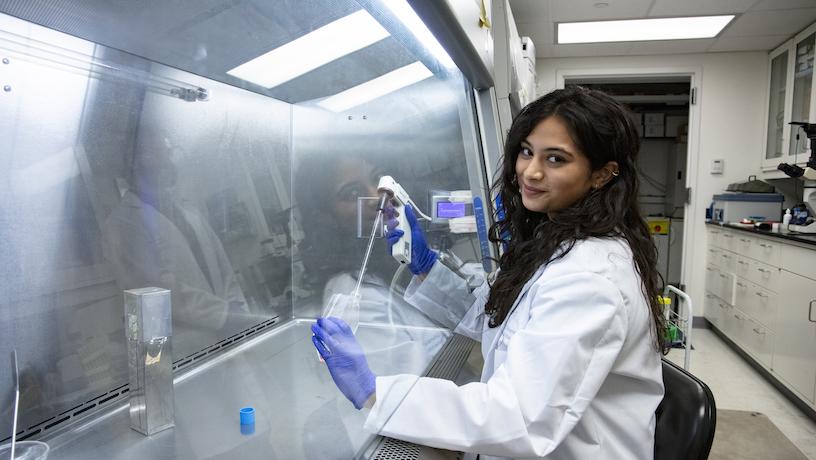
Aamna Siddiqui
Alfonso Rivas | Intelligent and Connected Systems Lab
- Mentor: Xiaofan (Fred) Jiang, Department of Electrical Engineering
- Home Institution: Syracuse University
- Hometown: Carolina, PR
Enabling Rapid Deployment of Low-Cost Scalable Fever Screening Network
Because of the recent COVID-19 pandemic, measuring people’s temperature has become a very standard and important physiologic indicator of disease. Most companies and government agencies use a thermal camera-based system to measure people’s temperature and determine if they have a fever. Sadly, most industry temperature measuring devices are misleading, inaccurate, and expensive, and many people misuse them by putting their hand, forearm, or other parts of their body in front of the temperature sensor, resulting in a misreading1. The SIFTER device uses an RGB-thermal camera to create a 3D model of a tracked subject’s head and find the specific temperature on his forehead. This low-cost system does not require the individuals to stop for their screening and can measure multiple individuals at the same time. In a test environment the SIFTER’s measuring error, or standard deviation, is about a 0.4 ̊F at 2m, while most temperature scanners in the market show a 1 ̊F standard deviation in 0.5m. With its accuracy, and ability to read temperature without any human interaction, the SIFTER outperforms the commercial baseline by a substantial amount. The device can be rapidly and easily deployed in any indoor area and uses a malleable holder, which allows screening from different angles. The goal is to have this device installed in most crowded places (i.e., malls, subway stations, etc.) to measure fever in individuals that have not realized they are sick and hopefully predict if a future pandemic is among us.
References:
1. Kaiyuan Hou, Yanchen Liu, Peter Wei, Chenye Yang, Hengjiu Kang, Stephen Xia, Teresa Spada, Andrew Rundle, and Xiaofan Jiang. “A Low-Cost In-situ System for Continuous Multi-Person Fever Screening” May 2022
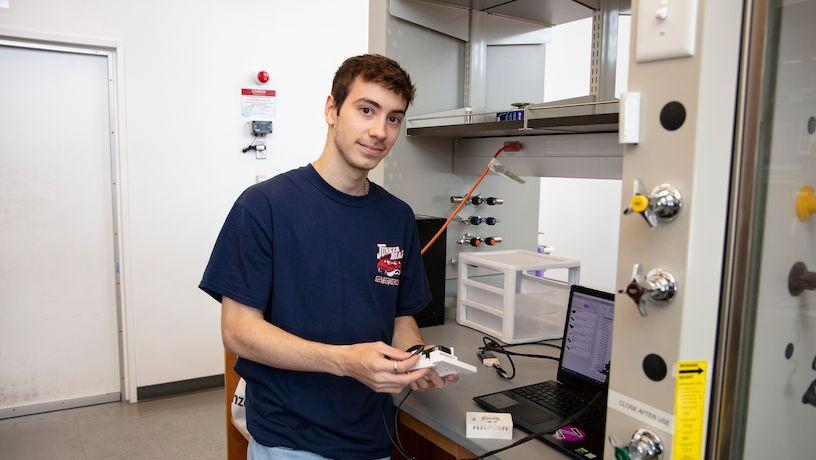
Alfonso Rivas
Asim Omi | The Hess Lab
- Mentor: Henry Hess and Juan Rodriguez, Department of Biomedical Engineering
- Home Institution: Stony Brook University
- Hometown: Queens, NY
Servo Motor Analysis for Maximum Force Produced
Motors of all types have a specific mechanism of producing force which translates to motion. The maximum force a motor can produce from the size scale of molecular motors to jet engines has been observed to lie on a power law between maximum force produced and the mass of the motor. It has been observed that most of the motors used by humans and animals for transportation have a common upper limit of mass-specific net force output that is independent of materials and mechanisms.[1] The fact that all types of motors have this relation suggests that there is some fundamental difference that limits the performance of motors. Understanding the limitations of the maximum force a specific mass of motor can produce is essential to overcome the technological capabilities of our motor design. In our lab, the goal has been to test the theoretical maximum force produced by the motors by exceeding the designated safety limitations placed by the manufacturers to verify if the motor falls on the relationship observed between maximum force and mass of the motor. We found the maximum torque of a servo motor can be exceeded by surpassing the rated voltage of the motor and the motor ultimately fails due to overheating. This indicates that the main constraint for electric motors is overheating of circuit boards inside the motor. Further research into incorporating an efficient cooling system for the specific motor experimented could result in looking into other limiting factors that restrict the motors.
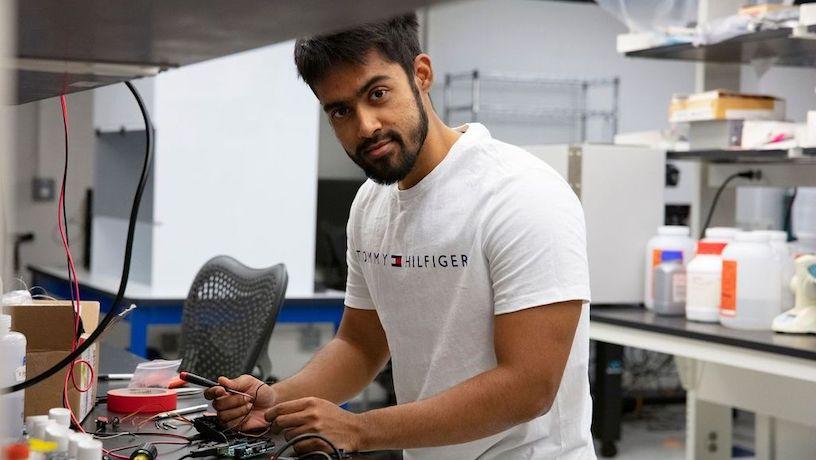
Asim Omi
Bianca Byfield | Kawashima Lab
- Mentor: Shiho Kawashima, Civil Engineering and Engineering Mechanics
- Home Institution: Harvard University
- Hometown: Eden Prairie, MN
Carbonation and grinding of recycled cement powder as an effective new method of carbon capture, utilization, and storage
The manufacturing of cement accounts for around 7% of global anthropogenic CO2 emissions [1]. Current methods of reducing these emissions involve replacing cement powder with supplementary cementitious materials (SCMs), which continues to be studied, or Carbon Capture, Utilization, and Storage (CCUS) methods such as carbon looping, which is energy intensive as it requires the captured CO2 to reach a concentration of 100% before it can be stored. Current research now proposes the use of carbonated recycled cement powder (RCP) from demolished concrete as a SCM, thus creating a new method of CCUS that improves upon SCMs and can be less energy intensive than carbon looping. This study explores the impact of carbonation of RCP and the use of grinding to make this process more efficient. By calculating the mass change of carbonated RCPs, performing thermogravimetric and differential thermogravimetric analysis (TGA-DTG) at multiple carbonation times, and comparing theoretical and experimental product content we were able to investigate the carbonation products and determine the impact of grinding. Our results suggest that the consumption of Calcium Hydroxide (Ca(OH)2) and Calcium Silicate Hydrate (C-S-H) in the carbonation process forms Calcium Carbonate (CaCO3). Additionally, our results indicate the grinding is an effective way of improving the carbonation degree of RCP. These findings support the idea that carbonated RCP as a SCM is an effective CCUS method.
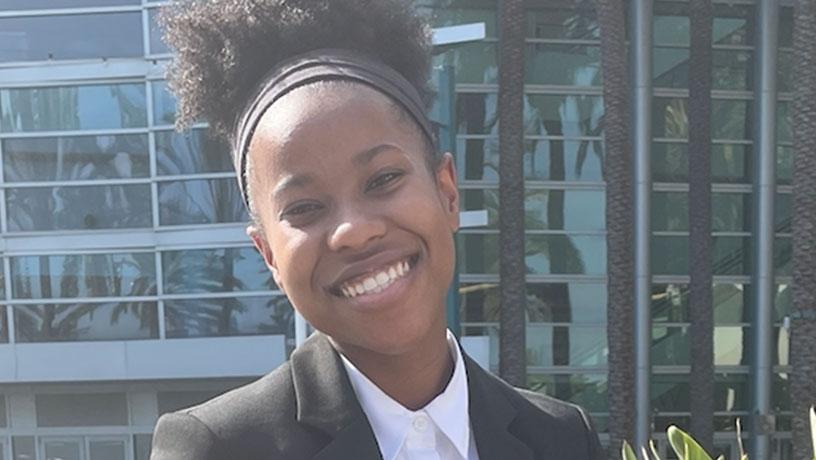
Bianca Byfield
Brandan Herron | Computer Artificial Intelligence and Robotics (CAIR) Lab
- Mentor: Shuran Song and Huy Ha, Computer Science
- Home Institution: Santa Monica College
- Hometown: Carson, CA
Can a 3D Reconstruction Algorithm be developed using NeRF
Introductions: Neural Radiance Fields (NeRF) is a fully-connected (non-convolutional) neural network that can generate novel views of complex 3D scenes, based on a set of 2D images. NeRFs represent scenes as implicit functions. The network’s input is 3D location (x, y, z) and a 2D viewing direction (θ, Φ) and the output is an emitted color (r, g, b) and volume density (α). NeRF takes 12 hours to train compared to 10 minutes to train when using Local Light Field Fusion (LLFF). However, NeRF only requires 5MB, compared to 15GB for LLFF (3000x more than NeRF).
Methods: We sample the 5D coordinates (location and viewing direction) along camera rays. We feed those locations and viewing directions into an MLP to produce a color and volume density. We then use the volume rendering technique to composite these values into a 2D image.
Results: For our test, we used a set of 177 images (a reflective cup, with a black coloring on the outer portions, white on the inter portions, with white writing that says “I heart NY” with a red heart on the outer portion as well) for the input data. Rather than use the cloud, we thought a linux computer would be efficient enough to run the experiment. Over a period of hours, we began to see the “I heart NY” and details on the wooden patterns of the table we placed our cup on began to appear.
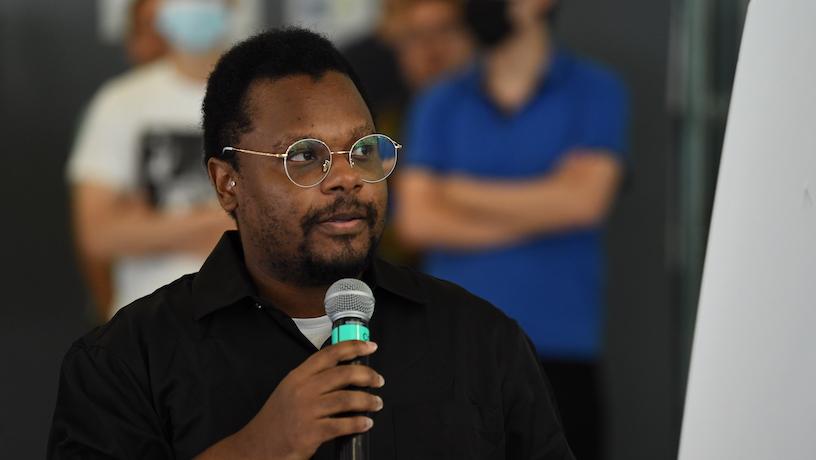
Brandan Herron
Bridgie Cawthon Jr. | Kumar Group
- Mentor: Sanat Kumar, Chemical Engineering
- Home Institution: University of Tennessee, Knoxville
- Hometown: Thomspons's Station, TN
Controlling the Hydrophobicity of Silica Nanoparticles by Altering Surface Chemistry
Polymerization initiated from the surface of nanoparticles requires compatibility between nanoparticles and common organic solvents like methyl ethyl ketone (MEK). Once polymer chains have been grown from the surface of the particles, the resulting "hairy" nanoparticles can be used to create gas-separation membranes with enhanced gas permeabilities and tunable gas selectivities. The issue at hand is that most commercial silica is hydrophilic and requires an altering of surface chemistry to disperse in organic solvents. As such, surface-initiated polymerizations can be only conducted with hydrophobically modified particles obtained from a manufacturer (Nissan Chemical, MEK-ST). LUDOX AS-30 is a commercially available product of silica particles dispersed into water at a high concentration (371 mg/mL). Dynamic light scattering (DLS) and small-angle x-ray scattering (SAXS) are used to quantify the size distribution of the starting silica colloid. A monodisperse particle size is observed (14-18 nm diameter), and the polydispersity in particle size relative to MEK-ST is significantly reduced. Next, we sought to control the hydrophobicity of the monodisperse particles. A 25 mL three neck reaction flask was used to conduct the reaction. A solution of LUDOX, Isopropyl alcohol, and water were added to the flask. The flask was heated to 70 oC in an oil bath operating under reflux conditions with stirring to allow solution to be homogenous. Hexamethyldisilazane (HMDS) was then added to react with surface -OH groups, converting them into trimethylsilyl (TMS) groups. After drying and qualitative filtration, the resulting powder was milled using mortar and pestle and then dispersed at high concentrations in MEK. Attenuated total reflectance (ATR) Fourier transform infrared spectroscopy (FTIR) was used to characterize the surface chemistry of the hydrophobically modified particles. DLS and TEM results, however, indicate that particles form small clusters during the drying process, which makes then unsuitable for surface-initiated polymerization. Future work will investigate the re-dispersal of the hydrophobic particles in MEK without forming clusters due to short-range van der Waals attraction.
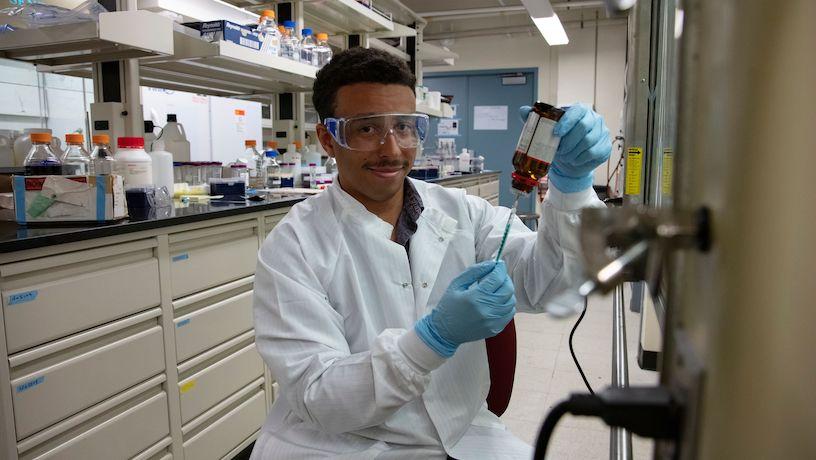
Bridgie Cawthon Jr.
Conrad Wyrick | CEAL Lab
- Mentor: Brian Smith, Computer Science
- Home Institution: University of Florida
- Hometown: Mary Esther, FL
Enhancing Blind and Low Vision Viewers' Ability to Visualize Tennis Gameplay via Co-design
In this work, we are making tennis videos more accessible to blind and low vision (BLVs) by recognizing gameplay directly from videos, i.e., from pixels. Sports plays an important role in bringing the community together, enhancing people’s cultural and social life. While past research has made efforts towards making sports media accessible to people who are BLVs, they usually rely on gameplay data collected via specialized hardware like on-field sensors, which is not always available. To help BLVs better visualize the game, we use a user-centered approach to design 3D-spatialized audio for feedback.
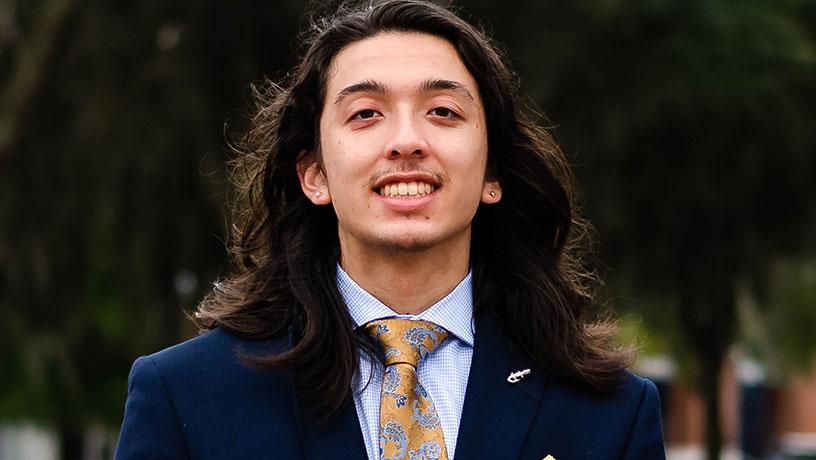
Conrad Wyrick
Courtney Chan | Sia Lab
- Mentor: Sam Sia and Vira Behnam Roudsari, Biomedical Engineering
- Home Institution: NYU Tandon
- Hometown: Queens, NY
Testing Polyacrylamide Hydrogel Microneedle Patches on Agarose Phantom Gels via Calcium Studies
All medical devices released on the market go through countless rounds of trials from a lab setting to clinical studies to ensure it’s safe for public use. However, errors and discrepancies occur when switching from the ideal lab setting to animal or clinical studies. To investigate this issue, researchers will develop gels of their desired test area, including skin-like/phantom gels and artificial perspiration. Using this methodology, researchers can pinpoint the errors and remedy them appropriately.
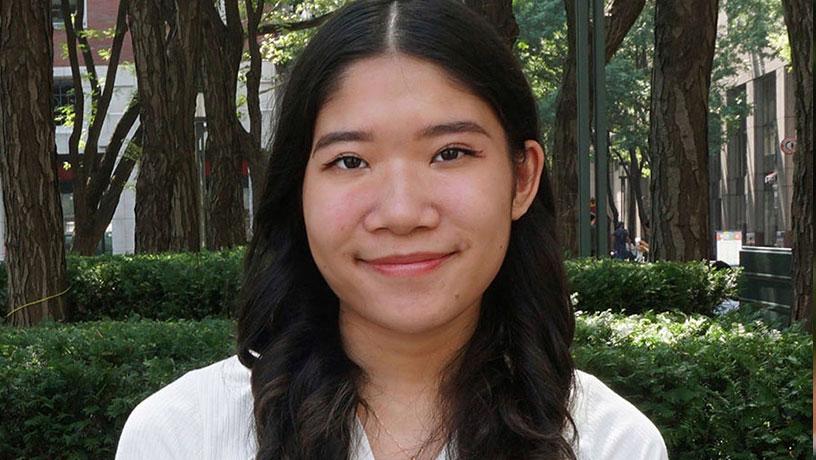
Courtney Chan
Dominic Peters | The Billinge Group
- Mentor: Simon Billinge, Applied Physics and Applied Mathematics
- Home Institution: The City College of New York
- Hometown: Bronx, NY
MongoDB Atlas Optimizes File Content Management System Performance
The U.S. Federal Materials Genome Initiative (MGI) exists to accelerate the solving of new materials using informatics, advanced modeling, experimental tools, and quantitative data. The initiative supports development of robust data infrastructures to be queried at scale by materials science, materials engineering, and industrial research communities. The MGI lends itself to FAIR database models. FAIR (Findable-Accessible-Interoperable-Reusable) dbs are valuable, ease-of-use computational tools that can be applied to materials-based research. A FAIR db must organize metadata and data structures for uniform queries and CRUD operations from thousands of users using various clients. The organizational system used by the Billinge Group for internal dbs is a file content management system called Regolith. As the internal dbs as the Billinge Group increase in size, the wall time of the Regolith software increases monotonically. This research explores extent to which Regolith data I/O subfunctions inhibit the software’s performance. Code modifications that remove the database loading subfunctions were integrated into the Regolith environment, and the wall times of the software were recorded to compare a MongoDB Atlas backend to an fs backend. Contrary to expectations, Regolith does not execute instantaneously on the MongoDB backend. MongoDB Atlas is a faster, more efficient backend than the local fs, however. As dbs increase in size and scale, MongoDB is an even better backend as it seems less dependent on file size than the fs.
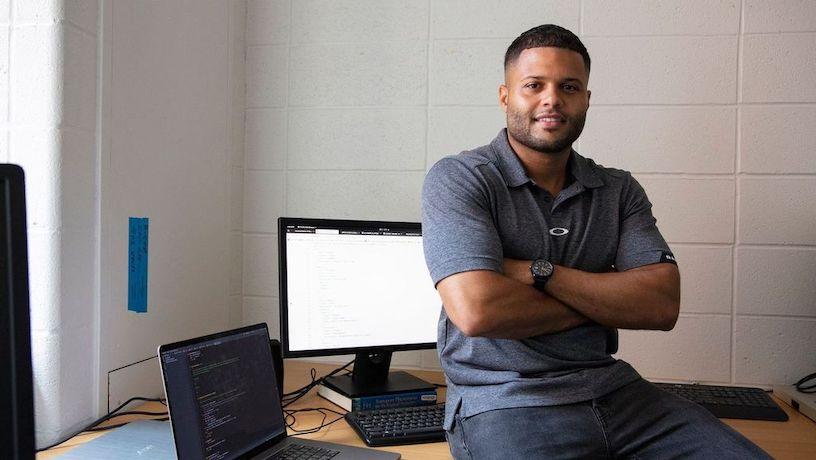
Dominic Peters
Duaa Tariq | The McKeown Lab
- Mentor: Kathleen McKeown, Computer Science
- Home Institution: CUNY Queens College
- Hometown: Queens, NY
Discourse Relation Parsing for Long Dialogues
Introduction: Discourse relation parsing is a research area in Natural Language Processing for analyzing discourse structure by identifying relations. Most previous works are limited to written texts which are well-structured, unlike spontaneous dialogues. I will be contributing a dataset consisting of discourse relations annotated for long dialogues, specifically transcripts of TV show episodes from the Forever Dreaming collection (Chen, 2022).
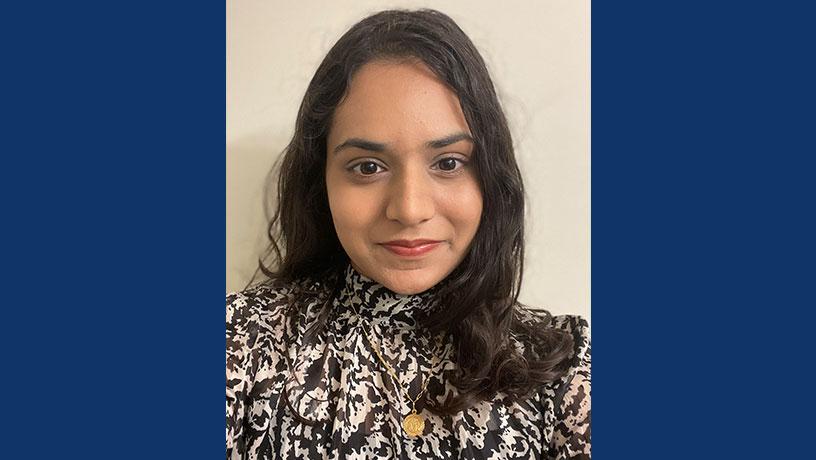
Duaa Tariq
Eve Fantozzi | Boyce Lab
- Mentor: Alireza Bordbar, Chemical Engineering
- Home Institution: Cornell University
- Hometown: Winchester, MA
Using Magnetic Resonance Velocimetry to Measure Fluid Flow through a U-bend
MRV (magnetic resonance velocimetry) is an analytical technique that utilizes nuclear magnetic resonance typically found in magnetic resonance imaging (MRI) technology. MRV provides a non-intrusive method to accurately measure fluid flow of both laminar and turbulent liquids. Engineers at the Department of Civil & Mechanical Engineering at the United States Military Academy, West Point issued an MRV challenge to several institutions to investigate turbulent fluid flow through a relatively simple U-bend geometry. Each research group used similar geometric dimensions and experimental conditions to obtain comparable data, and to ultimately determine the accuracy and efficiency of each MR scanner and post-processing techniques. Additionally, a CFD simulation was performed using OpenFOAM to ensure the accuracy of the MR experimentally collected data which was post-processed using Paraview. It can be concluded that due to novel post-processing methods and MR scanner technology, we were able to more efficiently obtain MRV data of fluid flow through an identical system as the four other participating research groups, without compromising accuracy of velocity data.
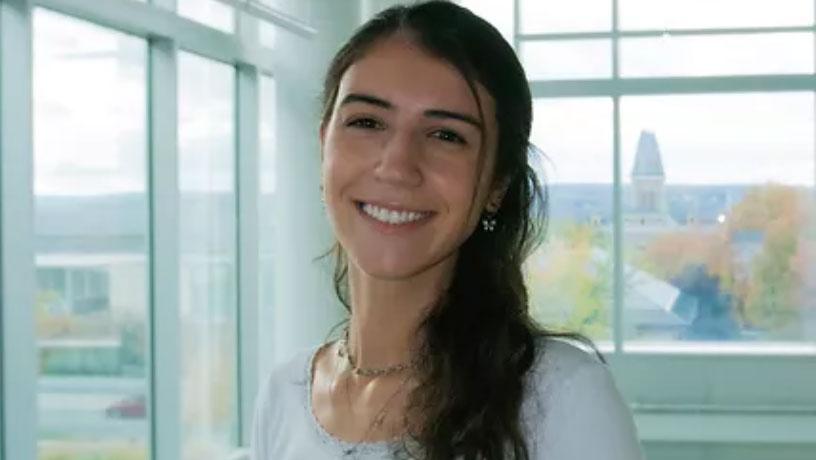
Eve Fantozzi
Gianna Brown | Structure Function Imaging Laboratory
- Mentor: Christine Hendon, Electrical Engineering
- Home Institution: UCLA
- Hometown: Moorpark, CA
Texture Analysis in Cervical Optical Coherence Tomography Images of Pregnant and non-Pregnant Women
Introduction: Pre-term birth is a dangerous complication that can occur during pregnancy that can be linked to premature remodeling of the cervix. Over the course of the summer, we attempted to identify this remodeling of the cervix using a noninvasive imaging technique called optical coherence tomography (OCT). This summer, we attempted to use texture analysis to differentiate between the OCT images.
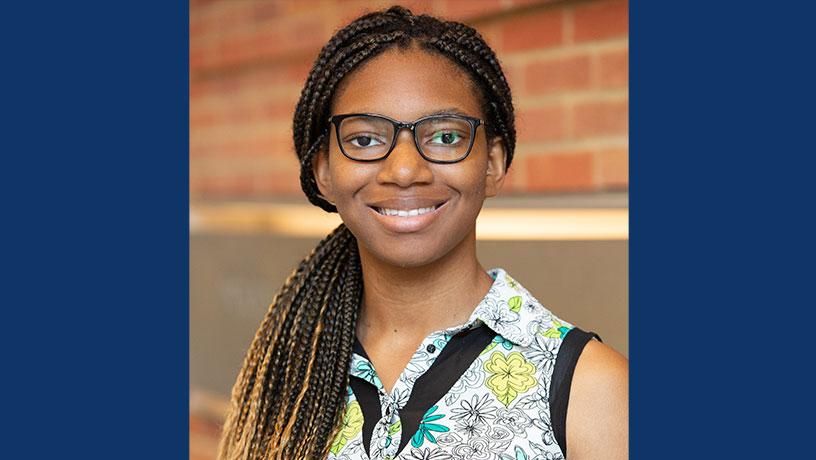
Gianna Brown
Gianna Scibilio
- Mentor: Mijo Simunovic, Chemical Engineering
- Home Institution: University of Florida
- Hometown: Orlando, FL
Manipulating Self-Organization of Stem Cells through Micropatterning
Introduction: Human Stem Cells (hSCs) stimulated by morphogens under standard culture in-vitro show some instances of self- organization and established signaling gradients, but the results are inconsistent [1]. Micropatterns are used to spatially restrict cells, helping cells self-organize and establish internal signaling gradients [1]. By evaluating endoderm development under both standard culture and micropatterns, we can compare the self- organization exhibited, giving insight into spatial restriction and the signaling hierarchy occurring in-vivo during early development.
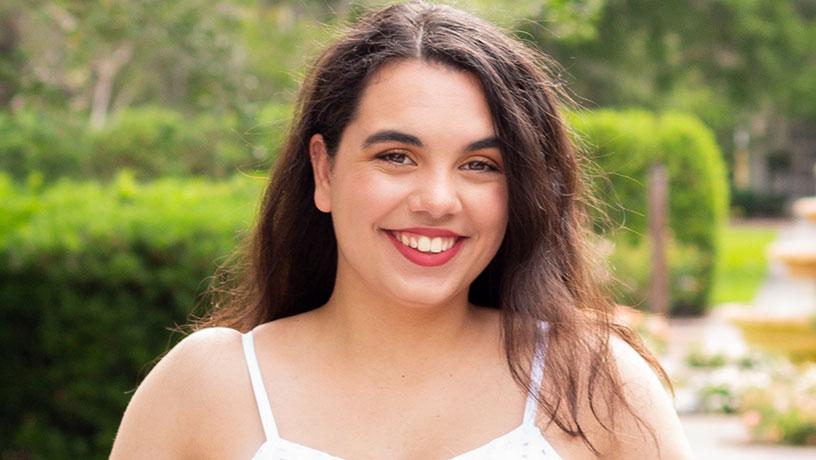
Gianna Scibilio
Hailey Onweller | Systems + Networking Lab (SNL)
- Mentor: Asaf Cidon, Electrical Engineering
- Home Institution: Penn State
- Hometown: Long Valley, NJ
Optimizing the Use of Differential Privacy for Time Series Workloads
Commercial and scientific applications require the use of private data. However, allowing these applications to use this data without compromising user privacy is a challenge. Differential Privacy (DP) enables applications to query datasets while protecting the personal data of individuals by adding noise to the responses. DP introduces the notion of a privacy budget, which allows queries to extract a budget on a particular segment of data, until the budget is depleted. DP has been widely studied for static datasets, but there is less related work in applications where data arrives dynamically. In particular, we are interested in time series applications, where new requests and data arrive at different times and rates. This leads to situations where the budget of recent data can become depleted, while older data remain underutilized indefinitely. We consider that data from different time periods may yield similar outputs for a given query. Therefore, this may allow us to interchange a segment whose privacy budget has been exhausted with an older segment that has a budget remaining. My contribution to the project has been to prepare a dataset and queries to demonstrate that interchanging data will not degrade query results, and leads to increased budget utilization.We use the New York Times COVID time series dataset, which shows periodicity over different time granularities that have a potential for interchangeability under DP queries (such as sum, and counts). This work shows that interchanging data in time series datasets provides promising results regarding optimizing the use of privacy budget.
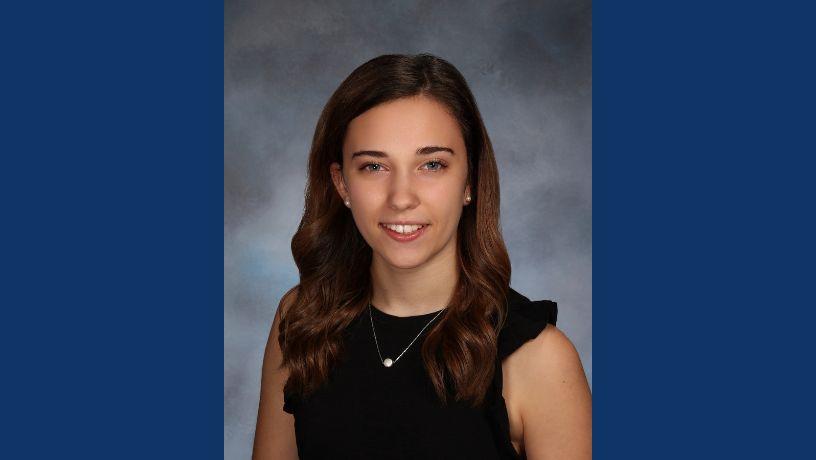
Hailey Onweller
Harshdeep Aujla | The Lall Lab
- Mentor: Upmanu Lall, Earth and Environmental Engineering and Civil Engineering and Engineering Mechanics
- Home Institution: Stevens Institute of Technology
- Hometown: Phillipsburg, NJ
Transforming Wastewater Infrastructure in the United States
The need to address the aging US Water Infrastructure has been articulated for the last 2 decades, with cost estimates ranging from $1 to 2 trillion. However, these estimates are uncertain as the current state of wastewater infrastructure is unknown and by extension, the effects posed to the nation’s population and ecological health. Further, without an understanding of the current scale of improvements required, the optimal financial and technical strategies required to improve America’s wastewater infrastructure cannot be selected or implemented Goal: To develop a complete census of Wastewater infrastructure in the United States of America which can be used to increase the efficiency of cities in the matter of planning for the repairs and funding for their wastewater infrastructure. Collect information about the current wastewater infrastructure in an area from real estate sites such as Zillow. Make a model that can predict what type of infrastructure system is being used in different areas by using common construction rules such as if a building is a septic system the whole street most likely has a septic system, and the same rule may apply in the case of the sewer system. Extract geographical data such as building footprint, roadmap, soil type, land use, and precipitation data using Python APIs such as EE, OSMNX, geemap, geopandas to create a database of factors that play role in the process of deterioration of the wastewater infrastructure.
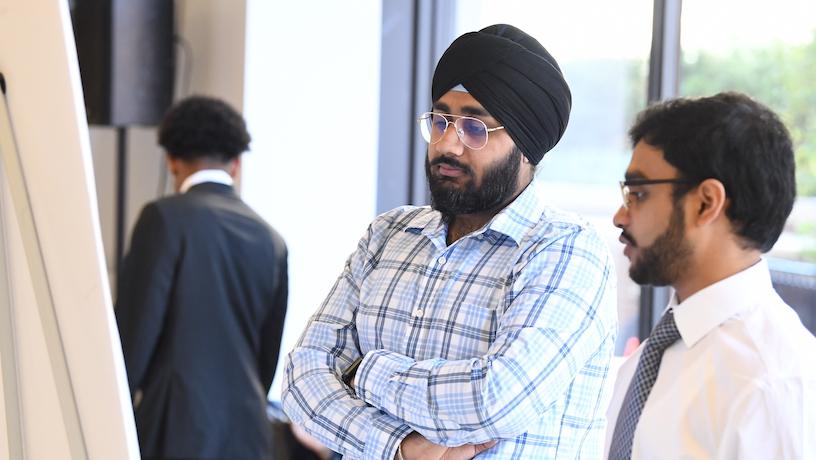
Harshdeep Aujla
Hayato Takai | Environmental Flow Physics Lab
- Mentor: Marco Giometto, Civil Engineering and Engineering Mechanics
- Home Institution: Washington University in St. Louis
- Hometown: New York, NY
Urban Greenery Project: Building a Park Using CFD and Satellite Imaging
Introduction: New research has shown that temperatures on a scorching summer day can vary as much as 20 degrees across different parts of the same city, with marginalized neighborhoods often bearing the brunt of that heat. Recent studies have shown that marginalized US neighborhoods, which have seen a long history of disinvestment and are more likely to have Black or Hispanic residents, consistently heat up the most. Low-income neighborhoods feature fewer urban trees and parks that help cool the air and have more paved sur- faces, such as asphalt lots or nearby highways, that absorb and radiate heat. Introducing green spaces in sweltering ur- ban environments is without a doubt, one of the most effective strategies to mitigate the urban heat island effect because they block solar irradiation and cool air through evapotranspiration. The goal of this project is to quantify air and sur- face temperature reductions resulting from the introduction of green spaces in urban areas. Satellite measurements and numerical models are used as methods.
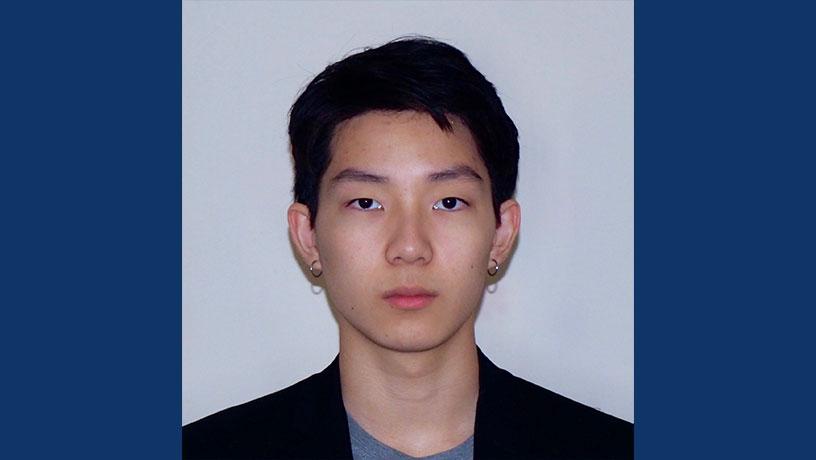
Hayato Takai
Isabel Wallgren | Biomaterials and Interface Tissue Engineering Laboratory
- Mentor: Helen Lu, Biomedical Engineering
- Home Institution: Emory University
- Hometown: New York, NY
Fabrication and Characterization of Immunomodulating Electrospun Fibrous Mesh
Introduction: Scarring is associated with extra-cellular matrix dysregulation1 and myofibroblast activation and 13. persistence.2 Nuclear factor kB (NF-kB) is correlated with impaired healing of rat rotator cuff tendons,3,4 human tendon scarring,5 and fibrotic diseases.6 NF-kB inhibition reduces myofibroblast activation in vitro6 and promotes tendon healing in vivo.4 2-Amino-6-[2- (cyclopropylmethoxy)-6-hydroxyphenyl]-4-(4- piperidinyl)-3 pyridinecarbonitrile (ACHP) suppresses the NF-kB inflammatory subunit IKKβ.4 The objective of this study was to incorporate ACHP into collagen-based fibers to locally target NF-kB in vitro to reduce scarring and promote tendon and ligament regeneration.
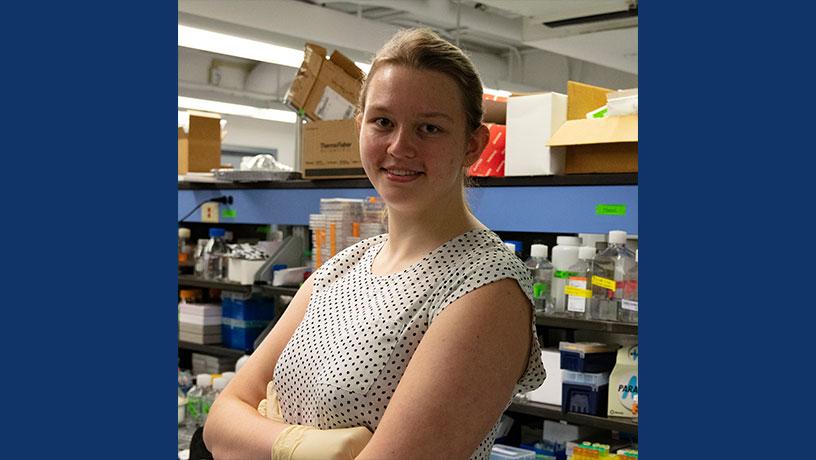
Isabel Wallgren
Isabella C. Huang | Kumar Group
- Mentor: Sanat Kumar, Chemical Engineering
- Home Institution: Macaulay Honors College at The City College of New York
- Hometown: Brooklyn, NY
Aging Effects on Polymer-Grafted Nanoparticle Membranes
Polymer membrane-based separation can be used to capture greenhouse gases, and it saves more money, energy, and space than distillation. The Kumar Group works to improve the permeability and selectivity of polymer-grafted nanoparticle (GNP) membranes, because the degree of enhancement increases as the graft chain length increases to around 90 kDa1. In 2020, Bilchak et al., found that different gas sizes are sensitive to different molecular weights of free polymers in GNP membranes2. Here, we studied how aging effects, specifically temperature and the addition of free homopolymers, change the structural properties of the GNP membranes by using in-situ annealing in the SAXS. We found that as the time increases, the membrane structure equilibrates at the set temperature. As the temperature increases, the peaks of the intensity curves narrow, and the membrane structure is more well defined; structure is defined by the highest temperature it sees. We conclude that higher temperatures cause closer packing in the blends. Based on gas transport, it is possible a low weight percent of chain scission occurs in GNPs with a high molecular weight graft at 110°C. Structurally, this membrane would be similar to a blend with a low weight percent of free homopolymers of the same magnitude chain length at 80°C. Further analysis is needed to understand the structural impact on blends at temperatures greater than 160°C.

Isabella C. Huang
Jade Carter | Robotics and Rehabilitation (RoAR) Laboratory
- Mentor: Sunil Agrawal, Mechanical Engineering
- Home Institution: Syracuse University
- Hometown: Albany, NY
Modulating Ankle Dorsiflexion with Exergaming during Overground Walking
Children with spastic diplegia, a form of cerebral palsy, have neurological impairments which lead to movement disorders in their lower limbs. Due to weak muscle control, these children are unable to produce enough ankle dorsiflexion during their gait cycle. Current training methods include contracting the ankle dorsiflexors during a seated task, yet a more dynamic training protocol while walking could lead to greater improvements. The goal of this study was to create an augmented reality exercise game (exergame) to modulate ankle dorsiflexion with overground walking in healthy participants. Participants wore an augmented reality (AR) headset to play the game. In the augmented environment (AE), four sets of five coins appeared at the approximate coordinates for a healthy participant's ankle range of motion positions during the stance phase of the gait cycle. Participants were instructed to position their feet correctly in order to collect as many coins as possible. Outcome variables include position, orientation of each foot in real time, and number of coins collected by each foot. This study produces a proof-of-concept verification for AR exergaming training which has the potential to be a beneficial method for treating toe walking and foot drop in children with cerebral palsy.
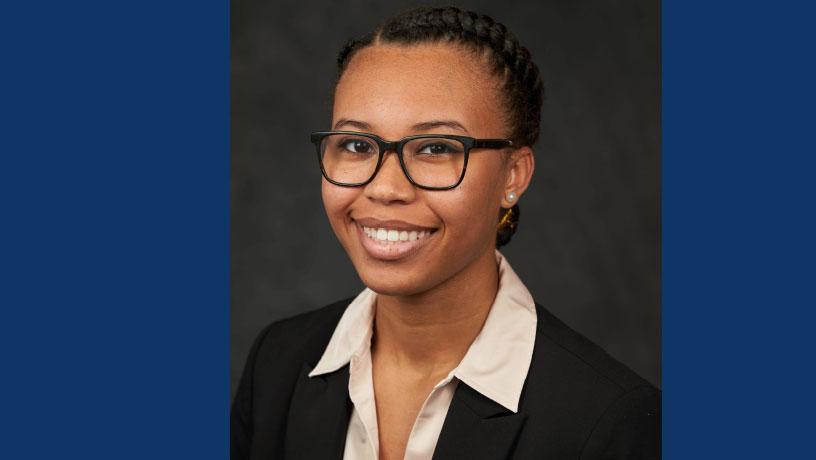
Jade Carter
Jake Joseph | Laboratory for Neural Engineering and Control
- Mentor: Qi Wang, Biomedical Engineering
- Home Institution: Washington University in St. Louis
- Hometown: Orlando, FL
Somatosensory Signal Detection Behavior Classification with Machine Learning Approaches
Neuromodulatory systems such as Norepinephrine (NE) and Acetylcholine (ACh) have predictable phasic patterns and play a critical role in sensory discrimination behavior. Future attempts to derive control systems for somatosensation will require an understanding of these neuromodulatory dynamics. From 40,000 total trials, we collected photometry recordings of NE and ACh fluorescent receptors from GRAB expressing mice (n=10) during a whisker deflection task. Each trial included a random onset time, followed by an air puff of 0, 2, 5, 10, 20, or 40 PSI and a 500ms window of opportunity to lick and retrieve a reward. We first hypothesized that neurotransmitter levels preceding stimulation could predict mice response. Additionally, given previous findings that GCAMP intensity was related to stimulation strength, we predicted data post stimulation would predict stimulation PSI. We used logistic regression, multi-layer perceptron’s (MLPs) and recurrent neural networks (RNNs) for these predictions. We found consistent dynamics across hit and miss trials, albeit large heterogeneity across individual animals. Logistic regression and MLPs reached 85% accuracy on lick prediction when trained on individual animals, however when trained on all animals’ accuracy dropped to 60%. Accuracy peaked at two seconds prior to stimulation. Neuromodulator activity proved unable to be decoded into puff strength. A RNN reached 80% accuracy when trained on all animals. These results show that individual mice’s neurotransmitter dynamics immediately prior to behavior can be modeled with a linear S curve, however, to generalize across multiple animals requires deeper networks that incorporate nonlinear temporal filtering in RNNs.
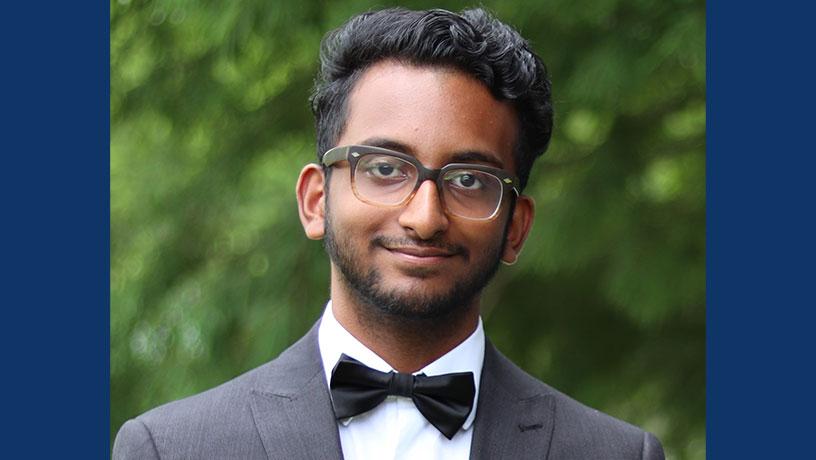
Jake Joseph
Jay Easter | Billinge Group
- Mentor: Simon Billinge, Applied Physics and Applied Mathematics
- Home Institution: University of Maryland Eastern Shore
- Hometown: Severn, MD
Investigating Preservation of Local Structure in 2-D Re6Se8Cl2 After Surface Functionalization
2-dimensional materials are promising candidates for next-generation technologies, and tuning their surfaces by molecular functionalization has been extensively explored for the purpose of achieving application-specific properties. Such surface functionalization often comes at the expense of other important material characteristics, such as changes in alignment and spacing of the layers. In this project, we investigate the preservation of structural integrity in 2-dimensional Re6Se8Cl2 ,first, after surface functionalization that involves replacing the Cl with H and, second, when heating the material to high temperatures. We investigated the structural integrity with X-ray total scattering data collected at NSLS-II and Fourier-transformed to the atomic pair distribution function (PDF), a technique that is unmatched in its ability to solve the structure of such short-range ordered materials. The modeling of the PDF data was done using the software PDFgui, using the data of the most local structure (r<9.4Å) as well as data at higher range (r=9.4-30Å). The PDF modeling of the local structure data showed that the short-range (r=2-9.4Å) order in the structural integrity was preserved after surface functionalization, although alignment and distancing of the layers were compromised. As such, we show that this method of surface functionalization maintains the local structure of the pristine material. We also measured PDFs over a temperature range of 89K-500K, and the peaks in the most local PDF indicated that the local structure was qualitatively unchanged in the entire temperature range. However, modeling of the local structure revealed abrupt changes in lattice parameters and atomic positions at approximately 400K. These changes in the local structure occur at the same temperature where a phase transition is observed in the average structure data. Further modeling is required to explore the details of the transition.
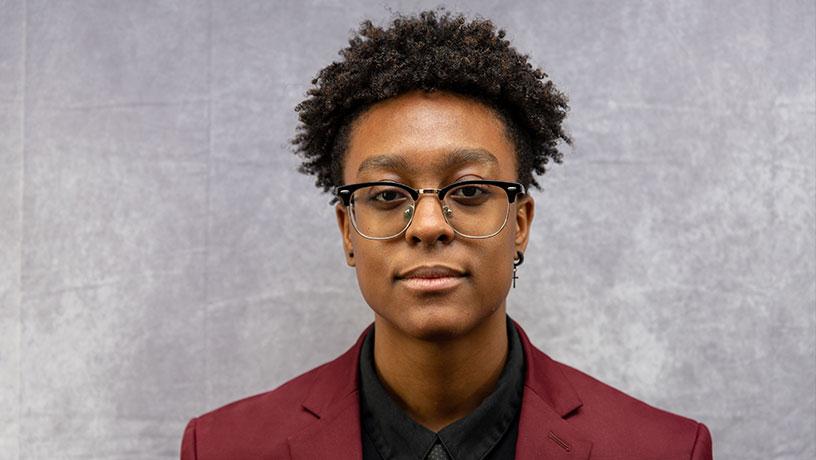
Jay Easter
Jazmyn Jenkins | CEAL Lab
- Mentor: Brian Smith, Computer Science
- Home Institution: Tuskegee University
- Hometown: Nolesville, TN
Unreal Engine Plugin for 3D Video Game Accessibility
Introduction: To combat the limitations on gaming in the blind/low-vision community, the CEAL lab developed NavStick, a system that helps visually impaired players (VIPs) “look around” in a game environment. It is an audio-based system that repurposes the right joystick into a 2-dimensional line-of-sight navigator. Our objective was to create a consumer-ready version of NavStick that is marketable to large-scale gaming companies. To increase the impact of NavStick, we decided to implement NavStick as plugin using Unreal Engine 5 (UE5). The goal was to create a minimum viable product (MVP) of this plugin. We developed a prototype of the system and onboarded an external developer to add advanced features. As a result, the NavStick plugin will soon be commercialized, making gaming accessibility more attainable.
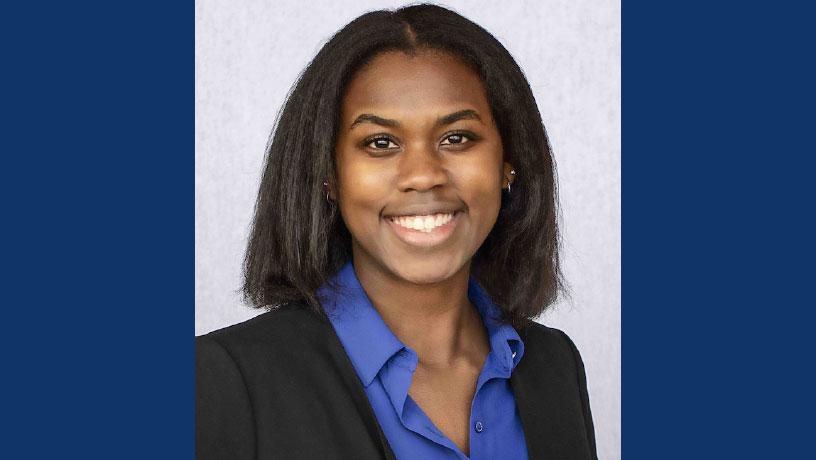
Jazmyn Jenkins
Jessica Quinones | The Sadja Lab
- Mentor: Paul Sajda, Biomedical Engineering and Electrical Engineering
- Home Institution: Georgetown University
- Hometown: San Antonio, TX
Communication and AI: How Trust in AI is Formed through Communication?
Our experiment worked to learn more about how people communicate with a simulated AI during a virtual reality game and the effect it would have on the trust level of AI. From participants that qualified, teams of 2 worked collaborated with an AI agent to play a virtual reality space travel game. The goal of the game is to properly control the spaceship to pass all rings and reach earth before the time runs out. The experiment relied on the human ability to trust and effectively communicate with AI to complete a virtual reality game. Communication for each round changed from no communication, one word command, and free communication. Every participant was connected to a VR headset, EEG, EKG and a microphone. All data was recorded and processed. On the occasion that the subject(s) did distrust the stimulated AI, it was seen in the results of the game. The team was more likely to fail and not successfully complete the game. This was true for all teams despite players' level of familiarity with one another. Once AI entered the game, the team dynamic shifted. The initial distrust typically faded from session to session as players became more familiar with the AI agent and increased their communication levels. By the end of the experiment, the most successful teams had great improvement in their communication.
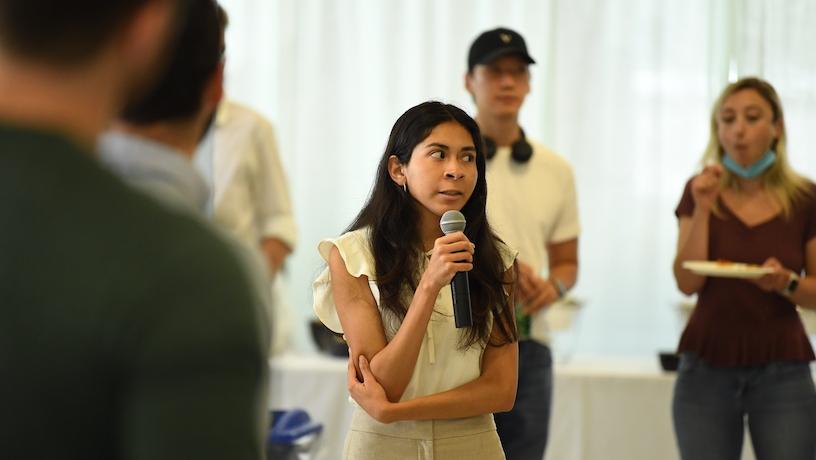
Jess Quinones
Jose Olivera | Computer Science Lab
- Mentor: Dan Rubenstein, Computer Science
- Home Institution: Syracuse University
- Hometown: Brooklyn, NY
Dynamic Ad-Hoc Network Simulator Using Bloom Filters
A Wireless Ad hoc network is a decentralized type of wireless network that does not rely on a pre-existing infrastructure, instead, each node participates in routing by forwarding data to other nodes. The determination of which nodes forward data is made dynamically based on network connectivity and the routing algorithm in use. In the case of the simulator developed by Dozier, Salamatian, and Rubenstein, a two-phase Bloom filter data structure is used where each node has two bloom filters. The nodes can switch between filters, store information, and verify whether a message has been added to the filter during and after the storing process.
The simulator was first written in Python. Olivera used C++ data structures to translate the simulator to C++. Classes with public variables and functions, inheritance, vector arrays, and separate functions were implemented during the translation of the program. Vector arrays were the best fit for the development of filters and node structures since they presented a faster access time to information than a list array.
During the translation of the simulator, Dozier and Olivera found a different approach for utilizing the two-phase bloom filter. They used a copy of each filter to secure real-time data. The main result of this project was to improve the program structure and its complexity time during situations where a large amount of data is broadcast in a network. This means that, instead of running for days, it could take just hours to communicate with all the nodes.
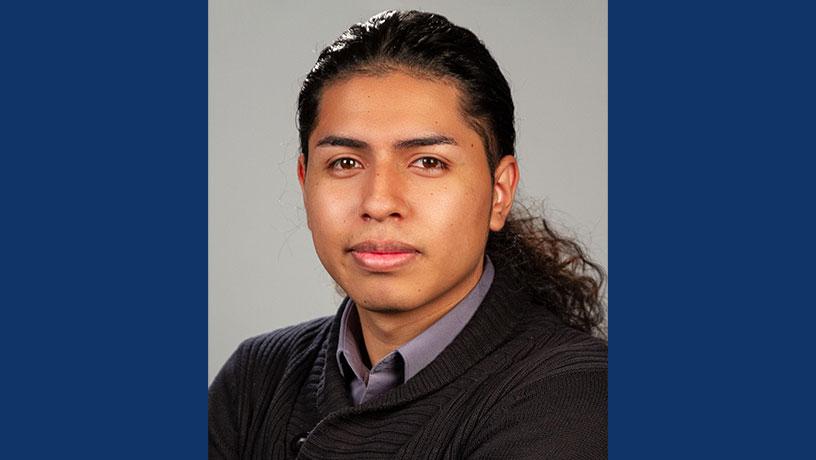
Jose Olivera
Justin Norwood | Boyce Lab
- Mentor: Chris Boyce, Chemical Engineering
- Home Institution: Tuskegee University
- Hometown: Mobile, AL
Faraday Wave Patterns with Active Forces
Producing Faraday waves with active forces has been an extensive research area. Using the applied knowledge for the faraday wave pattern, we were able to apply the understood study to Black Soldier Fly Larvae. These larvae are used to help decompose the 108 billion pounds of food waste that we produce every year in America. Using the applied studies of granular flow, the faraday waves are produced. Granular particles can behave like solids, liquids, or gas, according to the different shears. Many hydrodynamic instability analogs have been also found in granular particles for maximum efficiency, it is necessary to raise larvae in denser aggregations. With these denser aggregations some problems do arise. Challenges such as: the removal of larval metabolic heat, and distribution of food, the removal of uneaten food, the removal of solid and liquid waste. Using structured faraday waves will help alleviate these challenges by supplying constant air flow to the bed, and keeping the larvae moving in a fluid like state that allows the excess material to be syphoned out. Another benefit to raising the larvae in these dense3 aggregations is that the living larvae expand earlier during increasing flow and pack themselves for a more extended period during decreasing airflow. Contrary dead larvae aggregations expand and then contract and do not return to the original bed height. After taking all of these variables into consideration simulations were able to be successfully run, and we were able to extract the overall living data of the larvae.
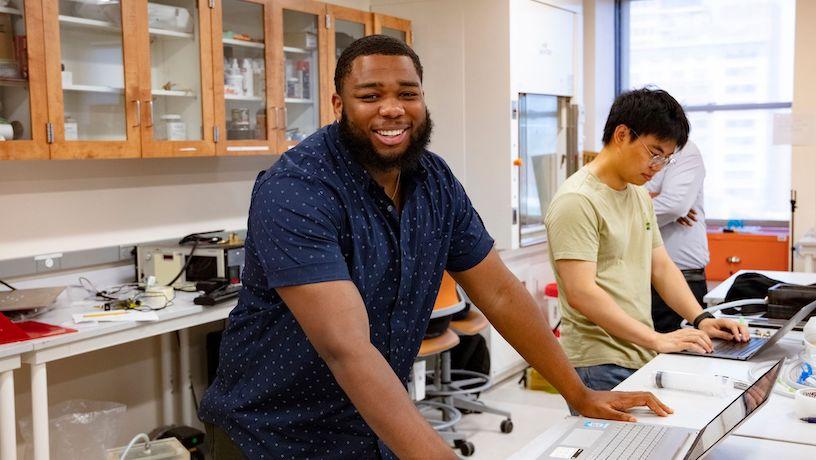
Justin Norwood
Justin Walkup | Environmental Flow Physics Lab
- Mentor: Marco Giometto, Civil Engineering and Engineering Mechanics
- Home Institution: Howard University
- Hometown: Fulton, MD
Urban Greenery Project: Building a Park Using CFD and Satellite Imaging
New research has shown that temperatures on a scorching summer day can vary as much as 20 degrees across different parts of the same city, with marginalized neighborhoods often bearing the brunt of that heat. Recent studies have shown that marginalized US neighborhoods, which have seen a long history of disinvestment and are more likely to have Black or Hispanic residents, consistently heat up the most. Low-income neighborhoods feature fewer urban trees and parks that help cool the air and have more paved surfaces, such as asphalt lots or nearby highways, that absorb and radiate heat. Introducing green spaces in sweltering urban environments is without a doubt, one of the most effective strategies to mitigate the urban heat island effect because they block solar irradiation and cool air through evapotranspiration. The goal of this project is to quantify air and sur face temperature reductions resulting from the introduction of green spaces in urban areas. Satellite measurements and numerical models are used as methods.
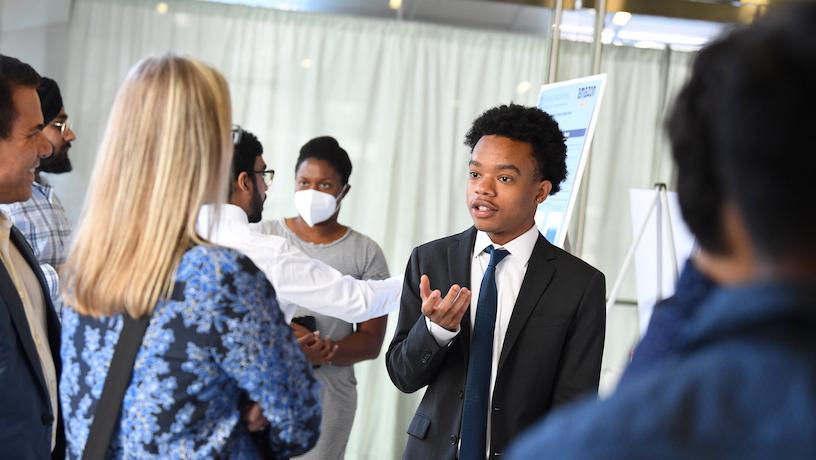
Justin Walkup
Lydia Kresin | Robotics and Rehabilitation (RoAR) Laboratory
- Mentor: Sunil Agrawal, Mechanical Engineering
- Home Institution: Tufts University
- Hometown: Santa Monica, CA
Effects of Auditory and Visual Cueing in Virtual Reality Environment for Parkinson’s Disease Gait Training
Background: A common symptom of Parkinson’s disease is impaired gait, including increased gait variability and reduced stride length and time, which greatly increases the risk of fall and fall-related injuries. Rhythmic auditory stimulation (RAS) and visual cueing have been demonstrated as effective therapies for stabilizing gait. However, there have been very few comparative studies on the aspects of gait most impacted by each therapeutic method and the effects of using both types of cueing simultaneously. Furthermore, less is known about the relationship between patients’ responses to auditory cueing and their musical experience/beat perception, which could affect the efficacy of the intervention. The present pilot study aims to evaluate the relationship between auditory and rhythmic cueing and the affected gait parameters. Understanding these effects could help identify the most effective rehabilitation approach tailored for individual patients. Methods: A virtual reality environment was developed which can provide either or both auditory and rhythmic cueing. Six healthy individuals (ages 19-28) were recruited for this study and completed a pre-survey assessing their musical background and beat perception ability. The participants’ gait parameters were measured as they walked on an instrumented walkway in a virtual environment under seven conditions: no cues (baseline), with auditory cueing, with visual cueing, and with both auditory and visual cueing (all with both normal and offset conditions). Results: Results revealed that temporal gait parameters (stride time and cadence) were impacted most under auditory cueing conditions, while spatial parameters (stride and step length) were changed most by visual cues, confirming that the paradigm is effective in changing these parameters. Conclusion: Results suggest that auditory and visual cueing cannot be used interchangeably, and using both types simultaneously may have further positive benefits. Further studies should investigate how people with Parkinson’s disease respond to a combination of both types of cueing.
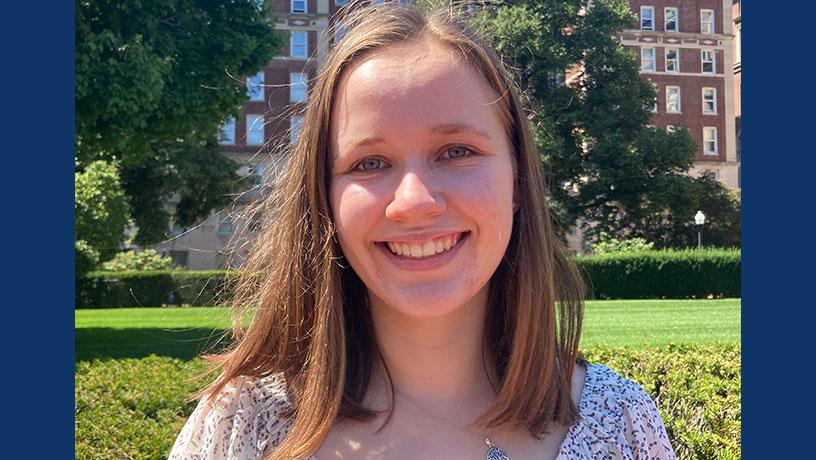
Lydia Kresin
Macarena Peralta | Computer Vision Lab
- Mentor: Carl Vondrick, Computer Science
- Home Institution: University of Michigan
- Hometown: Mount Pleasant, MI
Human Gesture Classification Model
The focus of this project is to create a supervised classification model to recognize videos of humans performing gestures, and categorize them into one of ten categories (e.g., shrugging, scratching head, shushing, etc.). Understanding the complex ways in which humans interact with each other and their environment is essential for the advancement of vision AI as it pertains to deriving meaningful information from people. Recognizing human mannerisms and gestures is a first step to achieve this level of understanding. We begin by identifying ten distinct categories via crowdsourcing where the gestures are universally agreed upon by the subjects. We begin data collection by gathering GIFs (graphics interchange format) for each gesture category by querying the Tenor API. We remove the GIFs that do not contain exactly one person or have an object obstructing the view of the person using the Detectron2 object detection software. After cleaning our data, we apply the AlphaPose model (pre-trained on Halpe dataset) which detects 136 keypoints on the body, hands, and face on the GIFs. Once we have the keypoint data, we prepare some visualizations comparing the raw video and the AlphaPose keypoint videos. We then perform an 80/10/10 data split for training, validation, and testing. We can then train, validate, and test the accuracy of our model for these ten gestures. We have setup the data processing pipeline in a way that can be easily updated to contain many more gesture categories in the future, thereby creating a robust framework for human gesture classification.
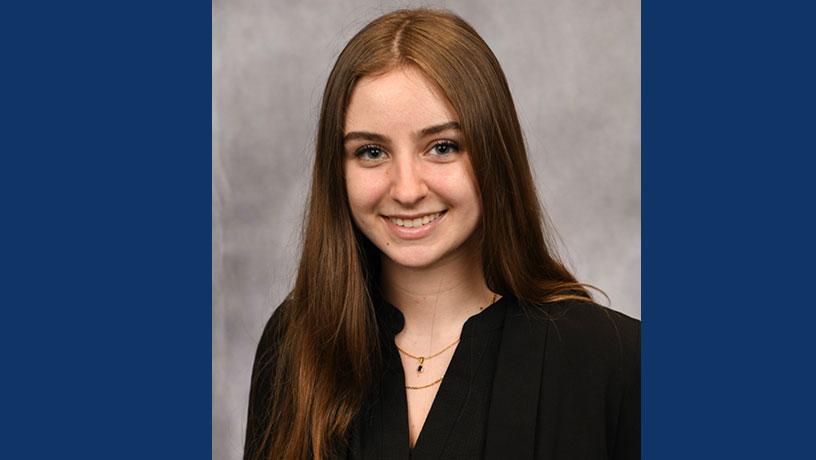
Macarena Peralta
Miccaella Lejwa | Myers Soft Tissue Lab
- Mentor: Kristin Myers, Mechanical Engineering
- Home Institution: Duke University
- Hometown: Nesbit, MS
Cervical Loading in Patients at Low-Risk for Preterm Birth for Tied and Sliding Fetal Membranes
Preterm birth (PTB), or delivery before 37 weeks gestation, globally affects 1 out of 10 births [1]. The current gold standard of PTB prediction is ultrasonic measurement of cervical length where short cervices are considered at high-risk for PTB, though this method is only 30-60% sensitive [2]. Loss of fetal fibronectin (fFN) is also associated with PTB, with fFN thought to adhere the fetal membrane to the uterine wall, though it can only be used to predict delivery within 7-10 days of collection [2]. Though current methods of PTB prediction indirectly examine the maternal biomechanical environment, very little is known about the biomechanics of a normal pregnancy. Therefore, my project focused on studying the normal loading of pregnant cervices that delivered at term by creating finite element simulations based on patient-specific geometry and cervical material properties. I used an existing method of building parametric patient-specific geometries from 2D ultrasound measurements to build models of the maternal uterus, cervix, fetal membrane, and abdomen in SolidWorks based on published ultrasonic dimension measurements at 14-16 weeks gestation [3]. All of the models were discretized in Hypermesh for finite element analysis (FEA). To incorporate patient-specific cervical stiffness, I used the patients’ corresponding cervical shear wave speed (SWS) data [4] correlated to cervical aspiration pressure [5] to find cervical fiber stiffness through inverse FEA. FEA setup was done in FEBio Studio [6]. Tissue material properties were based on existing mechanical tests and physiologically inspired boundary and contact conditions applied. An intrauterine pressure of 1kPa was assigned to the inner surface of the fetal membrane. To investigate the mechanical response in the cervix with the loss of fFN, I ran each patient’s simulation with two membrane contact conditions: 100% tied and 60-65% tied (sliding). Fifteen patients fully converged in both tied and sliding scenarios. As seen in Figure 1, the sliding heat maps appear to have higher levels of stretch than the tied heat maps. While this is not universally true (5, 10, 13, 14, 21), this could mean that loss of fFN increases in-vivo cervical stretch, potentially leading to PTB. Plotting individual ultrasound parameters against the 1st, 2nd, and 3rd principal stretches did not show any significant trends. However, as cervical stiffness increases, 1st principal stretch decreases, demonstrating that cervical stiffness plays an important role in supporting the intrauterine load.
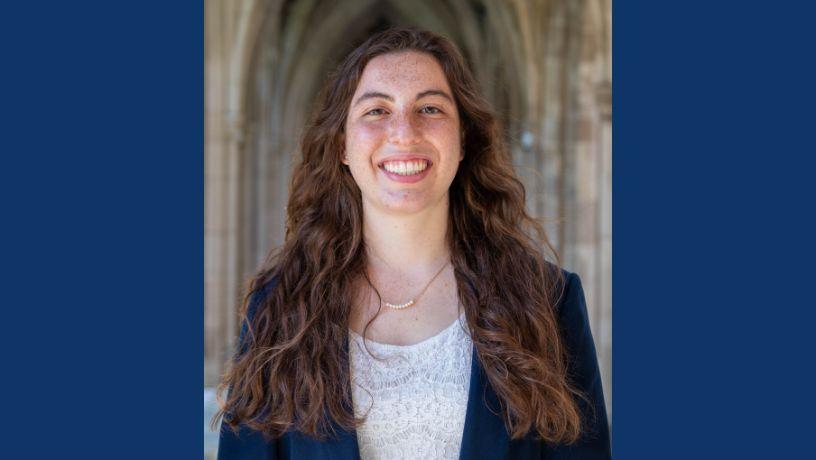
Miccaella Lejwa
Michael Jordan | The Bourtsalas Lab
- Mentor: Athanasios Bourtsalas, Earth and Environmental Engineering
- Home Institution: Tuskegee University
- Hometown: Oakland, CA
Waste to Energy Ash and Portland Cement Summer Research
The production of Portland Cement Concrete(PCC) for building material accounts for 7.4% of CO2 emissions and about 20 million tons of fly ash waste. Class C fly ash consist of calcium, alumina, and silica, provides early reaction results while being used during construction projects, maximum loss of ignition is 6%, has a lower bulk specific gravity than portland cement which means that the fine aggregate fraction of the concrete might need to be changed when conducting experiments. Fly ash is most commonly used as a pozzolan in PCC applications. Pozzolans are siliceous or siliceous and aluminous materials, which in a finely divided form and in the presence of water, react with calcium hydroxide at ordinary temperatures to produce cementitious compounds.Coal bottom ash contains a low amount of clickers, contributes to sustainable cement production, requires more water than fly ash due to the higher surface area, carbon in material absorbs more water than fly ash and the loss of ignition is 1.8%. This experiment explores the alternative uses for fly ash and bottom ash to be used in the production of bricks instead of being discarded in landfill.
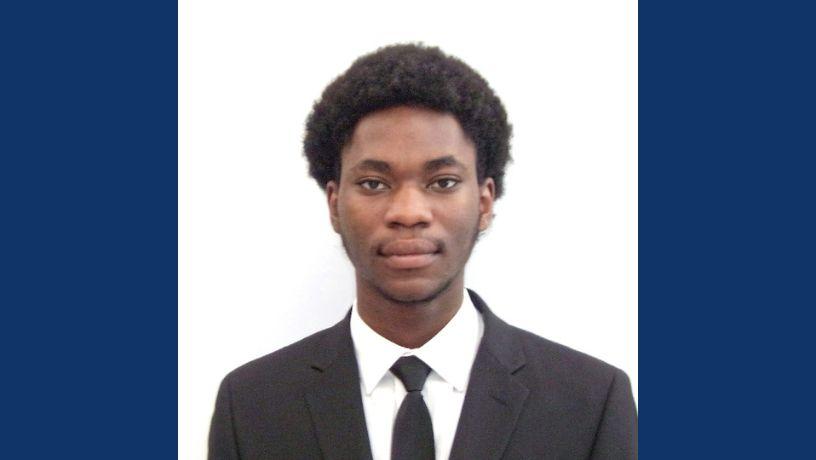
Michael Jordan
Mohamed Wagiealla | FSAE Group
- Mentor: Jeffery Kysar, Mechanical Engineering
- Home Institution: The City College of New York
- Hometown: Brooklyn, NY
Race Electric Vehicle Powertrain Chain Tensioning System
Abstract: There is one main difference between an Electric Vehicle (EV) and a conventional vehicle; one has a motor and another has a combustion engine. The drivetrain of a vehicle is just as important as what’s powering it since without it, the vehicle wouldn’t properly transfer the power to the wheels allowing it to drive. Unlike conventional vehicles, which use a multi-gear transmission, EVs are designed to operate with only one gear since it is easier and more efficient to regulate the motor itself than to regulate its output with an external system. As a result, mechanical power is transmitted directly from the electric motor to the differential, a part used to allow the drive wheels to spin at different speeds when cornering. The FSAE team at Columbia University used a sprocket and chain design to connect the motor to the differential. One problem when using the chain system is how to tension the chain properly so that the torque can get transferred uniformly which allows for a more secure and smooth drive. After conducting research, three design methods were introduced that can potentially become solutions to this problem. The first design uses an external pulley or sprocket that will apply load at a certain point on the chain. Second design is to use an eccentric mounting system that will move the differential away from the motor when rotated. Last design uses threaded rods to move the differential as well, but in this case allowing for an infinitely adjustable system.
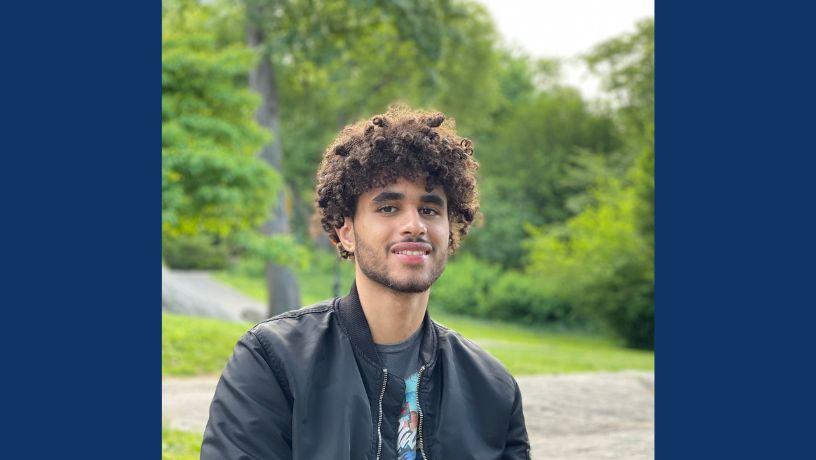
Mohamed Wagiealla
Nachum Twersky | Robotics and Rehabilitation (RoAR) Laboratory
- Mentor: Sunil Agrawal, Mechanical Engineering
- Home Institution: Columbia University
- Hometown: Flushing, NY
Using Fully Immersive Virtual Reality for Obstacle Avoidance Training
Tripping and falling are two of the most frequent causes of accidents among the elderly and consequently are a serious health concern. Clinicians have therefore created obstacle avoidance training and exercises. These exercises have been proven to improve gait characteristics and prevent falls. However, these trainings are limited to walking in a straight line and are conducted without a walking aid, even though a high percentage of falls occur while using walking aids. This study looks to test the effectiveness of fully immersive virtual reality obstacle avoidance training. This virtual training would allow the patient to use walking aids, progress at their own pace, and navigate a more challenging, diverse environment. The virtual obstacle course was made using Unity3D. (Unity Technologies, San Francisco, CA, USA). Subjects will be wearing an HTC VIVE Eye Pro VR headset and VIVE trackers on each foot (VIVE HTC PRO, Valve Corporation, Bellevue, WA, USA). Patients will walk along an instrumented mat (Zeno Walkway, Protokinetics, Havertown, PA, USA) for eight laps around a virtual track. Each lap has two different VR obstacles, set to 30% of the subject’s height. The patient must plan their footsteps accordingly to step over the obstacles in the virtual world. The parameters measured by the trackers are gait speed, gait variability and clearance distance over an obstacle. The obstacles can be changed and moved into different positions to provide an immense amount of flexibility and customization in this training. This flexibility allows clinicians to expand training to other affected groups and should help provide as many people as possible with the proper tools to minimize falls.
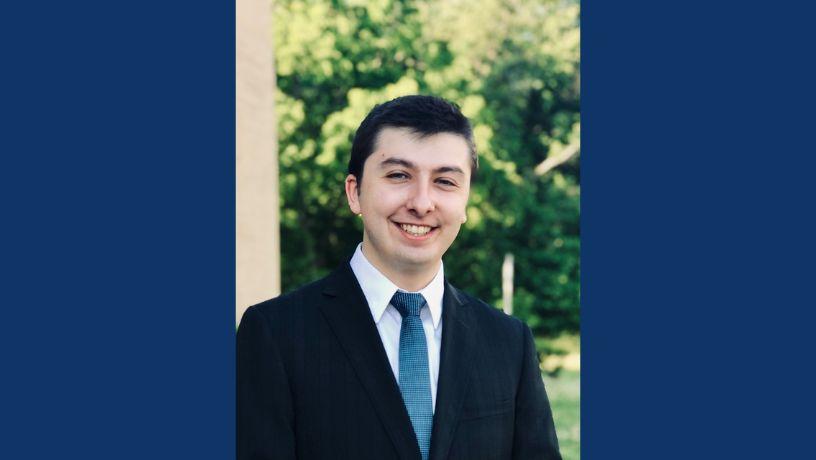
Nachum Twersky
Nia Cole | Intelligent and Connected Systems Lab
- Mentor: Xiaofan (Fred) Jiang, Department of Electrical Engineering
- Home Institution: Vanderbilt University
- Hometown: Dallas, TX
Digital Stethoscope for Diagnosis with AR/VR Organ Guidance
The stethoscope is an instrument used by medical professionals to listen to the internal organs of a patient. This assessment is medically known as auscultation. Based on the sounds heard, a medical professional can assess and determine the well being of the patient and status of the lungs, heart, and intestinal tract. Outside of the medical field audio analyzing technology has improved so much that smartphones can not only understand words and phrases, but they can now distinguish between the voice of its owner and other voices. This project is the next step in the possibilities of audio analyzing technology, deep neural networks, and the internal organ auscultation process. Recording sounds detected using a digital stethoscope, identifying the location of the sound, and classifying the type of sound using Deep Neural Networks can contribute to determining the diagnosis of a particular disease. Real-world applications of this device would allow underserved or low-resource communities the ability to monitor health conditions and receive a diagnosis without tests, expensive medical devices, and medical professionals. Our project will include AR guidance and feedback to the user as they go through the auscultation process. Our software then automatically analyzes the audio, providing a diagnosis. Ultimately, this product will increase healthcare access because high costs, access to medical supplies, and access to trained medical professions will not act as a barrier for underserved communities.
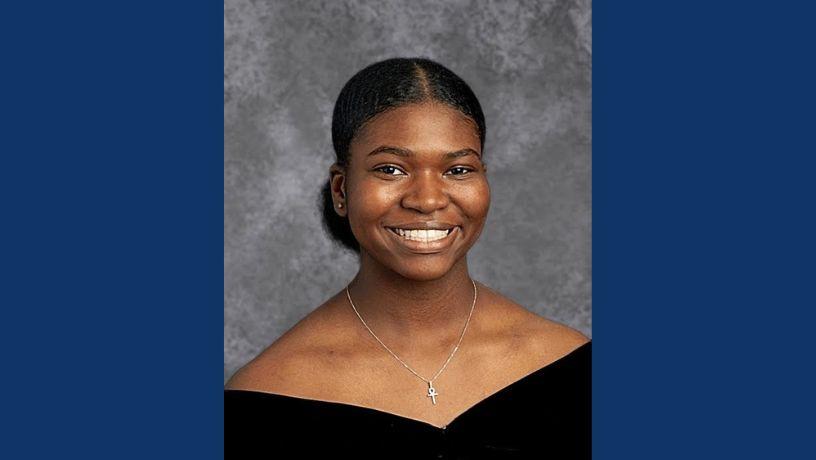
Nia Cole
Noah Robison | Nanotherapeutics and Stem Cell Engineering Lab
- Mentor: Kam Leong, Biomedical Engineering
- Home Institution: University of Tennessee, Knoxville
- Hometown: Memphis, TN
Scalable Fabrication and Gene Transfection of Size-Controlled Plasmid Nanoparticles by Flash Nanocomplexation for Oral Delivery
Introduction: Oral delivery is a preferred method of delivery for clinical translation of therapeutics, despite having some major drawbacks that must be addressed in the design stage. Flash nanocomplexation (FNC) is a new technology that has been shown to produce large quantities of stable nanoparticles (NPs) with a narrower range of sizes with a higher reproducibility. Methods: We utilized FNC (Fig. 1) to create a chitosan-polyethyleneimine (CS-g-PEI) polymer complex with plasmid DNA (pDNA). This polymer was tested in vivo and in vitro to determine its transfection efficiency with respect to the traditional process of handmaking NPs. Results: The FNC-prepared NPs showed major differences in several key factors compared to the vortexed NPs. The FNC-prepared NPs also showed higher efficiency in transfection during in vitro analysis when compared to the vortexed NPs (Fig. 2). The in vitro analysis revealed higher rates of local transfection with low rates of systemic transfection by the FNC-prepared NPs. Conclusions: The FNC NPs showed better results than the vortex-prepared NPs, likely due to the better complexing of the polymer with the pDNA. The FNC NPs transfected well locally, but systemic transfection occurred only at low levels, possibly due to difficulties with passing through the mucous layer of the stomach. Clinical applications using the CS-g-PEI polyplex need to be studied more extensively, as do its use in other genetic engineering methods, such as gene editing.
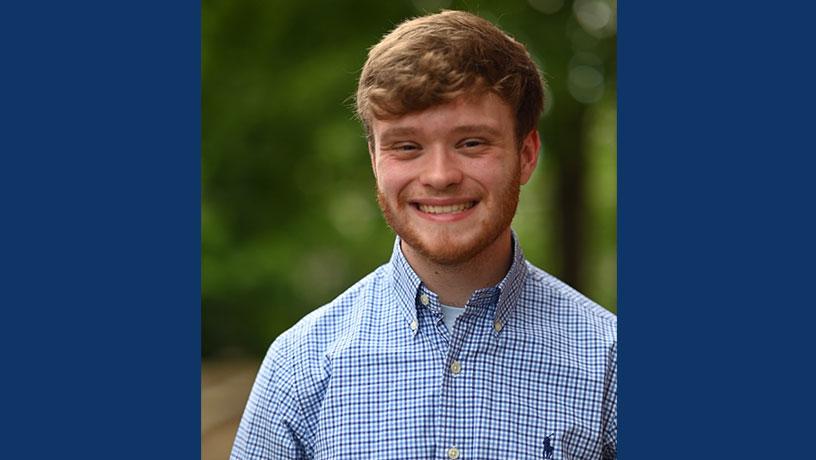
Noah Robison
Omar Dervisevic | Bone Bioengineering Lab
- Mentor: Xiang-Dong Edward Guo, Biomedical Engineering
- Home Institution: City College of New York (CUNY)
- Hometown: Astoria, NY
Ultrasound Expedites Decalcification of Mouse Tibia
The process of decalcification of a bone is necessary when histology and Immunohistochemistry (IHC) are performed. The decalcification time can be greatly decreased by the use of Ultrasound (US). To test how this works we will be placing the 4 mouse tibia under three conditions. The first condition will be to place 2 tibia under traditional decalcification in 10% EDTA for 2 weeks. The second condition will be to place 1 tibia in 2 liters of 0.5 M solution of EDTA in an ultrasound decalcifier. The third condition was to place 1 tibia in a beaker containing 200 mL of 0.5 M EDTA and place that beaker in a waterbath within the ultrasound decalcifier. The decalcification of the bones was assessed through the scout-view of the microCT. We then processed the decalcified samples, embedded them in paraffin, and sectioned the samples. The sectioned samples will then be stained with Hematoxylin and Eosin (H&E) stain and tartrate-resistant acid phosphatase (TRAP) stain. The results from the decalcification showed that the samples under ultrasound conditions decalcified much faster than the traditional decalcification method with the time required for the second condition being 48 hours and the time required for the third condition being 78 hours. The results from the histology showed excellent staining and that there was no significant difference in the staining between the samples. The results from this show that ultrasound can both expedite the decalcification process and the process could also use less materials making it more efficient.
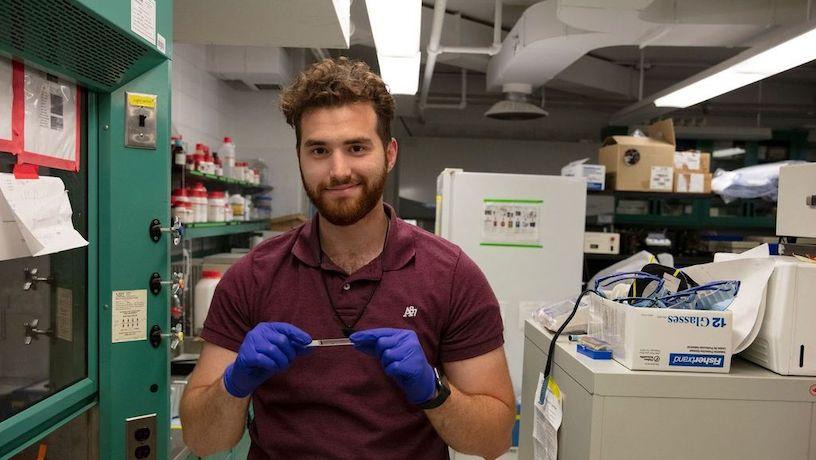
Omar Dervisevic
Prasun Dutta Gupta | Wright Lab
- Mentor: John Wright, Electrical Engineering
- Home Institution: Farmingdale State College
- Hometown: Bay Shore, NY
Energy Efficient Spectrum Sensing using Frequency-Domain Sparsity
Spectrum Sensing is very important for cognitive radios which is a terminal that can sense which channels are occupied by users and it is useful to prevent the harmful interference with licensed users and identify the available spectrum for improving the spectrum's utilization. Sparsity is in the nature of a signal which only contains a small number of non-zero elements compared to its dimension/total signal length which is visible in the Fourier transform. The property of sparsity is useful as this information helps us to understand that even if the signals itself stays in high dimensional space, they only contain only a few natural degrees of freedom.Compressed sensing is very useful in this project because it represents an idea where some measurements can be combined with different locations in some way and an algorithm will be in place to sort it out. This allows one to sense the RF spectrum with fewer measurements which makes the approach of combined measurement more efficient. A sample of a signal downloaded from github, is first plotted in the time domain which does not reveal the true nature of the signal. When the signal went through fourier transformation, the domain (x-axis) changed from time to frequency which reveals the sparse nature of the signal very clearly. The spectrum sensing can be formulated as a problem to a system of linear equations y = Ax using linear algebra. The sparsity on x makes the problem solving unique and more efficient.

Prasun Dutta Gupta
Riley Fisher | The Mandli Lab
- Mentor: Kyle Mandli, Applied Physics and Applied Mathematics
- Home Institution: Duke University
- Hometown: Winchester, VA
Validation Study of the GeoClaw Software: Modeling Hurricane Hugo
The goal of this project was to conduct a validation study on a storm surge modeling software in order to determine the ability of the model to handle estimations of missing data and detailed topography. Modeling geophysical flow and wave propagation problems are vital in the response to natural disasters. The GeoClaw branch of the Clawpack software package models tsunamis, storm surges, and debris flows. I modeled hurricane Hugo using this software and compared the results to real-world data. Missing storm data was extracted from existing data to run the simulation. Water levels at three gauge stations were used as comparative data. The model was run at varying degrees of specificity to balance accuracy and timing efficiency. I manually increased refinement at the gauge locations to increase spatial accuracy only where needed. The simulation ran for two of the three gauges. General timing and height of the surge matched at these gauges. This suggests that estimating the missing data did not hinder accuracy. The model was able to refine areas with detailed topography while maintaining efficiency to an extent. Further research includes running the simulation with higher refinement levels, modifying the model to account for river topography, and extending the estimations of missing data to create fully synthetic storms that can model effects due to climate change.
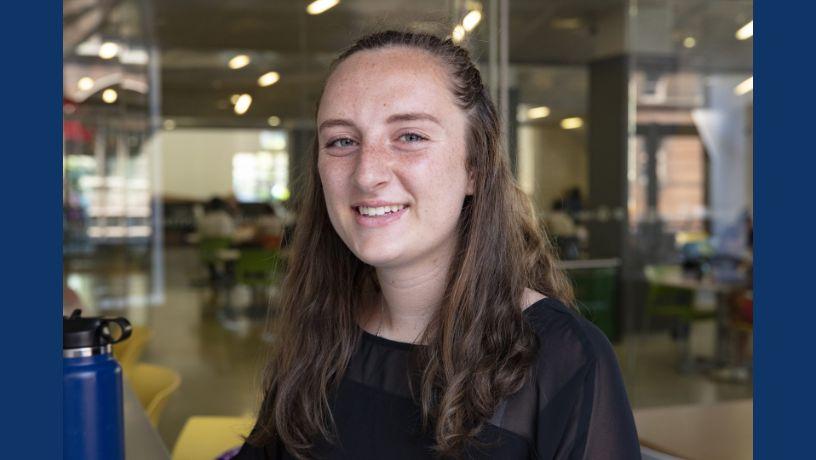
Riley Fisher
Robert Ward | WuLab
- Mentor: Eugene Wu, Computer Science
- Home Institution: Syracuse University
- Hometown: Bangkok, Thailand
SQL Query Visualization Using Data Provenance
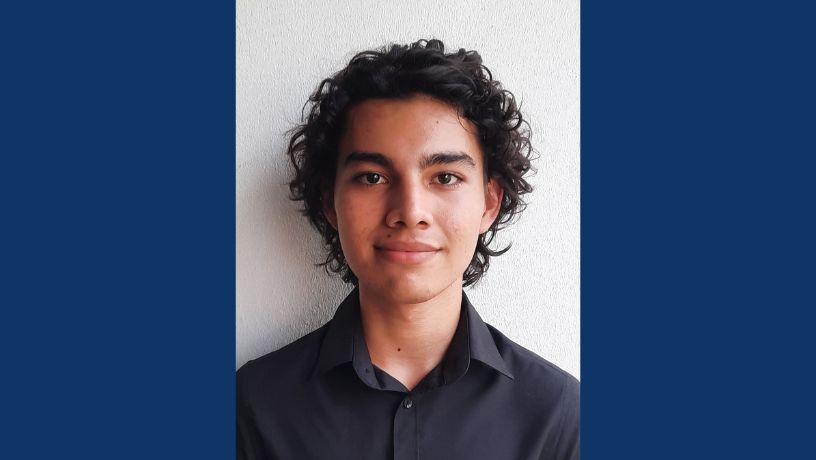
Robert Ward
Samuel Cohen | Wimnet Lab
- Mentor: Alon Levin, Electrical Engineering
- Home Institution: Yeshiva University
- Hometown: Teaneck, NJ
COSMOS: Enabling Next-Gen Wireless Research
Next-generation wireless networks will utilize both millimeter-wave (mmWave) frequencies and full-duplex (FD) radios to improve networks through increased data rates, reduced latencies, and more efficient usage of the wireless spectrum. [1,2]. Due to the high path loss at mmWave frequencies, accurate channel measurement and modeling for different deployment sites are required. The most difficult challenge when deploying mmWave antennas is the loss of power when there are obstacles between the transmitter and receiver. In order to evaluate the severity of this difficulty, I participated in an extensive mmWave channel measurement campaign with over 1,500 links on 13 sidewalks which was conducted in the COSMOS testbed deployment area that is located in West Harlem, New York City. Self-interference cancellation (SIC) is critical to FD wireless communications and takes place across various domains in the transceiver architecture. To enable full-duplex operation, the self-interference (SI) signal leaking from the transmitter to the receiver must be maximally suppressed, as it is often a billion times (> 90dB) stronger than the desired receive signal. A self-interference canceller integrated circuit (IC) operating in the radio frequency (RF) and analog baseband (BB) domains [3] is composed of taps with variable gains and delays that can be adaptively configured to maximize SIC. Finding the optimal canceller configuration is challenging due to the large configuration space and the effects of non-linearities and non-idealities in the physical system. I participated in the implementation of a high bandwidth Gen-3 FD radio which is now being extended to support link-level experimentation.
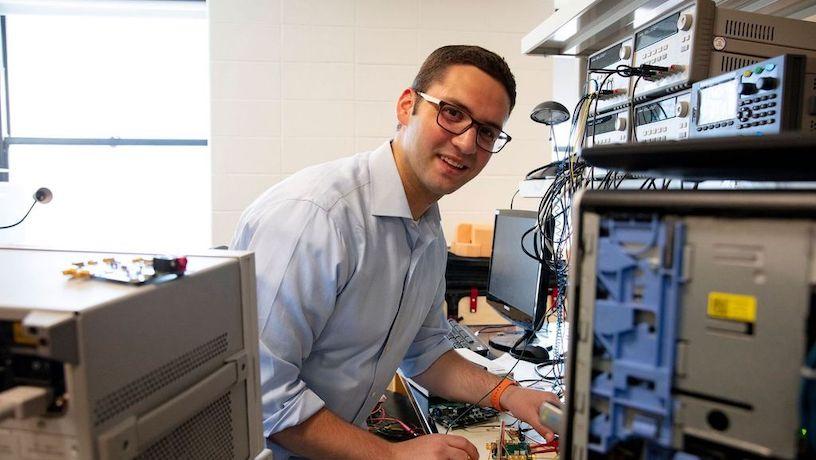
Samuel Cohen
Sara Kesan | Ultrasound and Elasticity Imaging Lab (UEIL)
- Mentor: Murad Hossain, Biomedical Engineering
- Home Institution: Smith College
- Hometown: Champaign, IL
Monitoring the progression of breast cancer in an orthotopic-4T1 mouse model using single transducer harmonic motion imaging
Breast cancer is the second leading cause of cancer-related death in women in the USA1 . Mammography and ultrasonography are generally used to screen patients for breast cancers4 . Instead of mammography and ultrasound-based morphological imaging, ultrasound elastography (USE)-derived mechanical properties like elasticity can be used to detect breast cancer as the breast tumor is generally stiffer due to increased deposition of collagen fiber. One of the USE methods uses acoustic radiation force (ARF) to displace tissue at the micron level and uses ultrasound pulse to estimate the displacement. From the estimated displacement, the elasticity of tissue is inferred. Single transducer harmonic motion imaging (ST-HMI) is an ARF-based method to assess the elasticity of tissue by using a single ultrasound transducer to generate and track harmonic oscillation7 . Previously, ST-HMI-derived displacements at a single frequency indicated that the stiffness of a tumor increased over time relative to non-cancerous background tissue in a 4T1 mouse model6 . Instead of collecting one frequency data at a time, multi- frequency ST-HMI was used to collect 100-1000 Hz oscillation data in a single acquisition7 . The objective of this work is to monitor the progression of a tumor in an orthotopic-4T1 mouse model using multi- frequency ST-HMI and investigate the performance of each oscillation frequency. 8-10 week old female BALB/c mice were anesthetized and injected with 2 × 105 4T1 breast cancer cells in the 4th inguinal mammary fat pad6 . Multi-frequency ST-HMI was performed using Verasonics Vantage Ultrasound System (Vantage 256, Verasonics Inc., Kirkland, WA, USA) with an L11-5 linear array transducer at 7, 12, 18, and 25 days post-tumor-cell injection6,7. ST-HMI-derived peak-to-peak displacement (P2PD) images were generated at oscillation frequencies of 100-1000 Hz with increments of 100 Hz. In Mouse # 1, the P2PD ratio increased over time at each oscillation frequency with slope [0.33 – 0.69] and R2 [0.80 - 0.88]. In Mouse # 2, the P2PD ratio stayed the same or increased depending on the oscillation frequency with slope [-0.045 – 0.13] and R2 [0.014 – 0.71]. The increase in the P2PD ratio indicated that the tumor was stiffening over time relative to the background tissue. Tumor size also increased over time, but the method of calculating tumor size could be improved. Future work will analyze P2PD ratio in a larger sample of mice to explore why stiffness increased faster in Mouse # 1 and slower in Mouse # 2 with histopathological validation.
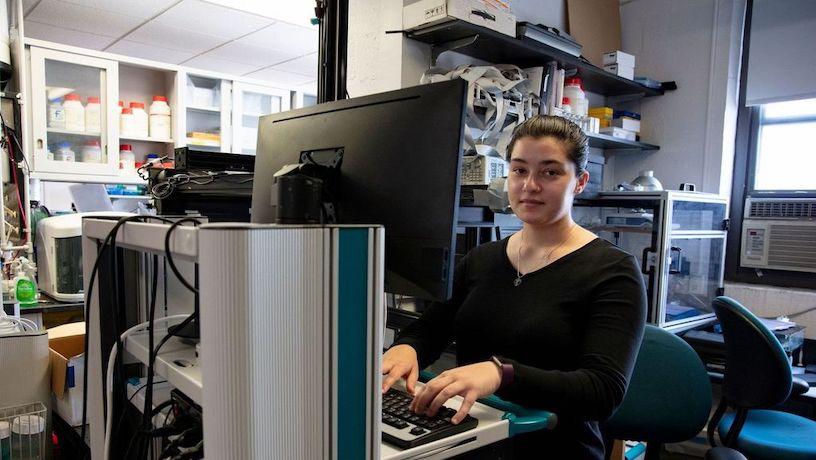
Sara Kesan
Sasha Kucher | The Mandli Lab
- Mentor: Kyle Mandli, Applied Physics and Applied Mathematics
- Home Institution: NYU
- Hometown: Stamford, CT
Storm Surge Validation Study of Hurricane Iota
The decrease in air pressure during a storm results in flooding, or a “storm surge”. By using the shallow water equations, we can predict the extent of flooding based on the velocity and position of the associated hurricane, as well as the bathymetry of the sea floor. To do this, we used Clawpack, a tool used to solve first order hyperbolic partial differential equations. Geoclaw solves geophysical flows.
This study in particular will use Clawpack to model hurricane Iota, and compare the predicted storm surge against the measured values in order to test the accuracy of the Clawpack software.
Data on hurricane Iota was gathered directly from NOAA, topographical data was gathered on gebco, and storm surge values were given by INETER (Nicaraguan Institute of Territorial Studies).
The conclusion that was drawn was that clawpack was unable to generate a model that accurately depicted the storm surge values posted by Ineter. Additionally, the lack of data the program can handle indicates either incorrect boundary conditions or a memory leak.
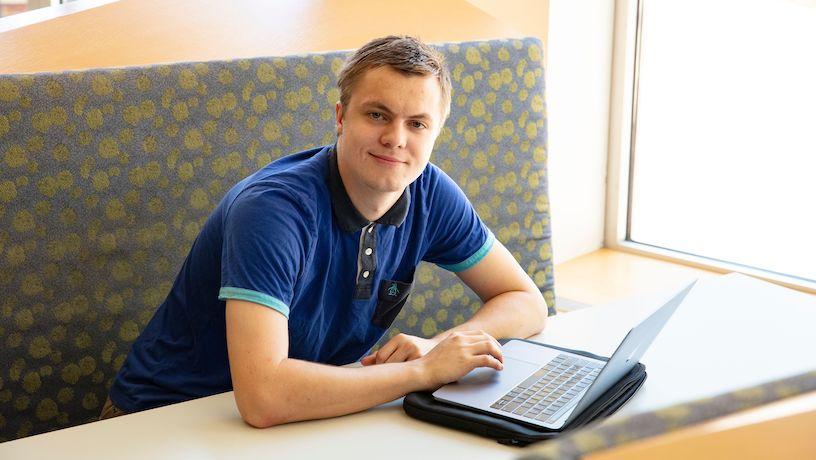
Sasha Kucher
Stephanie Morales | O'Shaughnessy Group
- Mentor: Hokang Zhu, Chemical Engineering
- Home Institution: San Diego State University
- Hometown: San Diego, CA
Refolding mechanism of the SARS-CoV-2 Spike protein for cell entry
The SARS-CoV-2 uses the S protein to enter the cell which consists of the S1 and the S2 subunit. Once the S1 binds to the ACE2 receptor on the host cell membrane and dissociates from the S2, then the S2 allows the entry of the virus. The structures of the pre-fusion and the post-fusion stage are known but the fusion intermediate (FI) is poorly understood. During the FI stage, the S2 C-terminus connects to the viral membrane, and the N-terminus binds to the host membrane. We ran all-atom molecular dynamics simulations to study the refolding mechanisms of the refolding of the FI. To accelerate the simulation, we simulated a specific part (residues 980-1200). At the initial condition, the HR2 helices are parallel to the backbone. After 30 ns the RFH and the HR2 destabilize which causes some parts of the alpha helices to become unstructured. These 30 ns were just a portion of the Fusion Intermediate stage. We believe that after a long period of time, the RFH gets fully unstructured and interacts with the golden peptides. Once the RFH and the HR2 are unstructured, the host and the virus membrane come together and the infection spreads into the rest of the cells in our body.
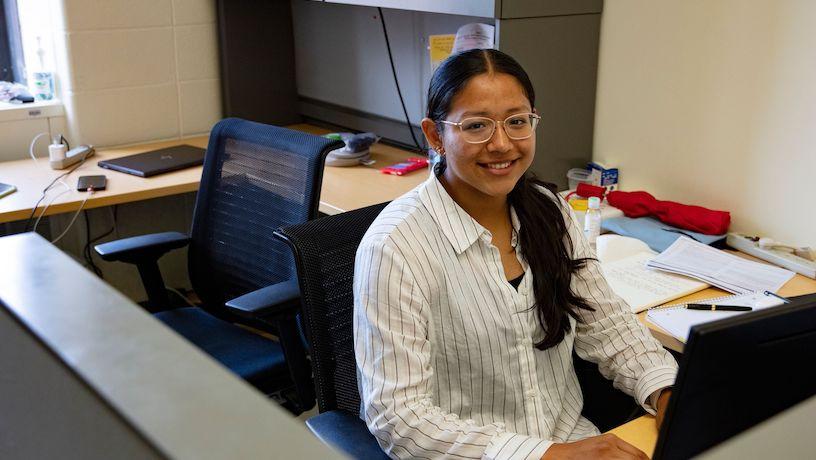
Stephanie Morales
Tiffany Kalu | The Bourtsalas Lab
- Mentor: Athanasios Bourtsalas, Earth and Environmental Engineering, Computer Science
- Home Institution: Harvard University
- Hometown: Dallas, TX
The Utilization of Waste-to-Energy Incineration Ash in Clay Fired Brick Manufacturing
Introduction: Waste-to-Energy (WTE) plants combust municipal solid waste (MSW) with energy recovery, effectively reducing the weight and volume of MSW, leaving WTE ash behind. The fine fractions of WTE ash are difficult to incorporate in building materials due to its particle size. This research aims to investigate the feasibility of using the fine fractions of WTE ash in partial replacement of clay in fired bricks.

Tiffany Kalu
Tiffany Nieto | McFaline-Figueroa Lab
- Mentor: Nicholas Hou, Biomedical Engineering
- Home Institution: St. John's university
- Hometown: Brooklyn, NY
Perturbing in place: Systems for in situ and cell-type specific single-cell genetic screens
GBM is a malignant brain tumor that develops from a specific type of brain cell called an astrocyte. GBMs are often very aggressive and spread to surrounding tissues. Only 3.3% and 1.2% of patients survive the illness after two and three years, respectively. 2 Some of the most common symptoms are persistent headaches, seizures, memory loss, changes in mood and personality, and speech difficulty.1 The complexity of the tumor itself is one of the causes of GBM's resistance to therapeutic intervention.

Tiffany Nieto
Victoria Tung | BITEL Lab
- Mentor: Helen Lu, Biomedical Engineering
- Home Institution: Vanderbilt University
- Hometown: Cupertino, CA
Laser Cutting as a Method of Creating Perforations in Engineering a Regenerative Biomaterial for the Periodontal Ligament
Periodontitis is a common and progressive disease characterized by the degradation of the periodontal ligament and alveolar bone that anchors a tooth in place, which often leads to the eventual loss of the tooth. In addition to mechanical stability, the periodontal ligament is important for absorbing forces associated with mastication and providing sensory information about tooth position. Current therapies focus on stopping the progression of periodontitis rather than the regeneration of the tissues and often consist of complicated and expensive dental procedures. In contrast, we are approaching the treatment of periodontitis through a regenerative therapeutics lens which utilizes a triphasic and electrospun gelatin-based biomaterial scaffold that promotes the regeneration of the periodontium through biomimetic design. We are currently focusing on recapitulating the periodontal ligament by creating perforations in our nanofiber scaffolds through laser cutting that mimic the native region. Through an iterative design process, we are refining our laser cutting method fabrication parameters to create these perforations, cell culture seeding methods on to perforated scaffolds, and observing the consequent cell behavior and response.

Victoria Tung
Wendy Zimmerman | Ultrasound and Elasticity Imaging Laboratory
- Mentor: Alec Batts, Biomedical Engineering
- Home Institution: Syracuse University
- Hometown: Brooklyn, NY
Effect of Aging and Biological Sex on the Acoustical Properties of Murine Skulls
Opening the blood-brain barrier (BBB) using focused ultrasound (FUS) and peripherally-administered microbubbles, via acoustic cavitation, is a promising technique for targeted drug delivery to treat neurodegenerative disorders, such as Parkinson’s Disease and Alzheimer’s Disease. To reach the intended target in the brain, the FUS beam must pass through the skull, a structure which causes varying beam distortions due to its complex structural properties. To achieve consistent therapeutic effects across subjects, the effects of age and biological sex on these properties should be understood and corrected for. Excised murine skulls, varying in age, strain, and biological sex, were degassed for over 24 hours before beginning attenuation experiments to ensure proper acoustic coupling. The center of the acoustic focus of a 1.5 MHz FUS transducer was first localized in a custom-made water bath using a needle hydrophone to perform raster scans of the acoustic field in the axial and circumferential dimensions. Free field measurements were taken prior to skull placement in the path of the ultrasound beam and acquisition of insertion loss (Insertion Loss = Regional Pressure Free Field Pressure ∗ 100) measurements in the left and right frontal and parietal regions. A statistically significant difference between the average insertion loss for male and female mice was observed (Fig.1A). No statistically significant differences in average insertion loss between the three defined age groups (young mice 0-6 months old, middle-aged mice 7 months-1.7 years old, and old- aged mice 1.8-2.3 years old) were found, however, a globally linearly increasing trend (R2=0.6804) was observed (Fig.1B). For female mice, a significant increase in average insertion loss between the age groups was found, exhibiting a strong linear correlation (R 2=0.9942). A small, albeit statistically insignificant, increase in average insertion loss was detected among male mice across the age groups, with a strong linear correlation (R 2=0.9771), (Fig.1-C). Though there were many limitations to this study, a main one being the difficulty in accounting for variability in skull structure, aging in female mice was shown to lead to a significant increase in insertion loss. Further work can be conducted using micro-CT analysis to quantify the changes in the microstructure of the skulls, specifically the thickness and porosity, which may explain insertion loss results.
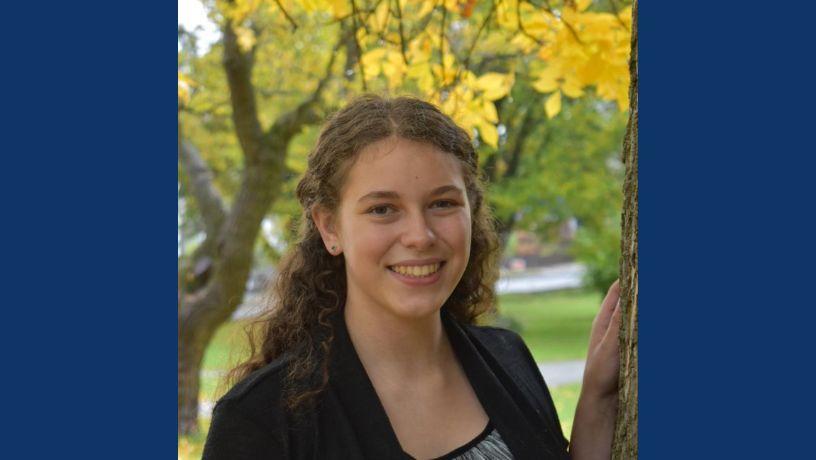
Wendy Zimmerman
Zachary George | The Balkanski Lab
- Mentor: Eric Balkanski, Industrial Engineering and Operations Research
- Home Institution: University of Illinois Urbana-Champaign
- Hometown: San Jose, CA
Exploring Greedy Algorithm Effectiveness in Real World Matching
Introduction: Even though greedy has the worst case out of all the possible matching algorithms in this study it focuses on figuring out why it is the most effective in real world capabilities. For instance, companies like Uber/Doordash use greedy algorithm to match the server (driver) to the user (person requesting). The idea of greedy is essentially matching the newest user to the unmatched server. In experimental studies there are real-time taxi with 10000 users and servers and results are surprising cause even though its worst-case greedy beats out the other matching algorithms like HST and is almost on par with offline matching. Therefore, the goal of my project is to test why through programming test trials in python that will allow me to use randomized data.
